Trace Van Gogh’s nomadic life through this illustrated timeline that details his homes, careers, and works.
March 30, 1853
Groot-Zundert, the Netherlands
Van Gogh is born in his parents’ parsonage.
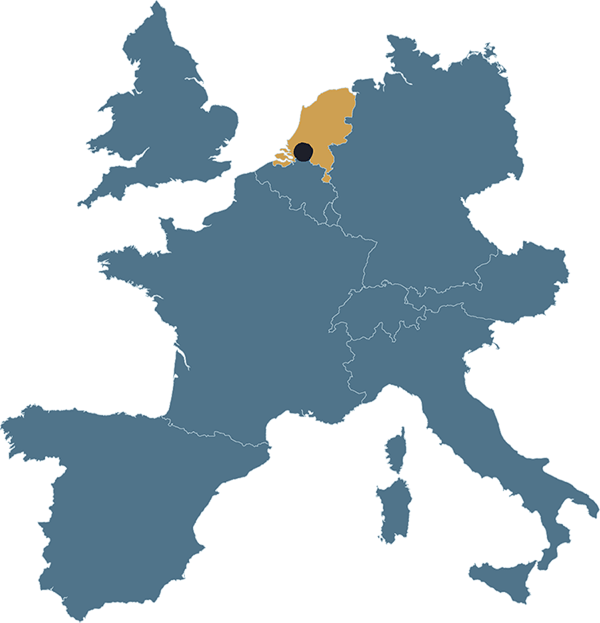
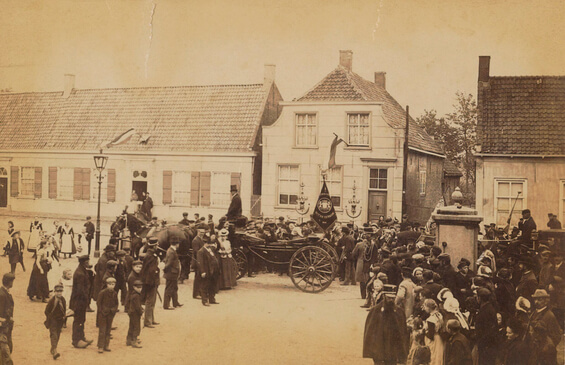
The Markt in Zundert with the Van Gogh parsonage at center. Van Gogh Museum, Amsterdam, Archives.
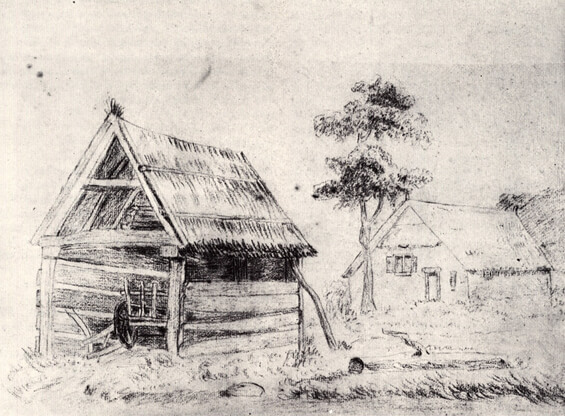
Van Gogh’s earliest known drawing. Van Gogh. Barn and Farmhouse, Feb. 8, 1864. Pencil on paper; 20 × 27 cm (7 ⅞ × 10 ⅝ in.). Scholte–van Houten Collection.
October 1, 1864
Zevenbergen, the Netherlands
Resides at Zandweg A40 while attending Jan Provily’s boarding school for boys.
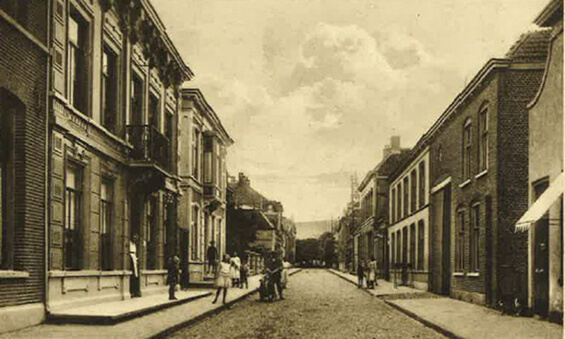
Stationsstraat in Zevenbergen with Jan Provily’s boarding school (white building on the left)
September 3, 1866
Tilburg, the Netherlands
Lives at Korvel 57 with the Hannik family while attending the Willem II high school.
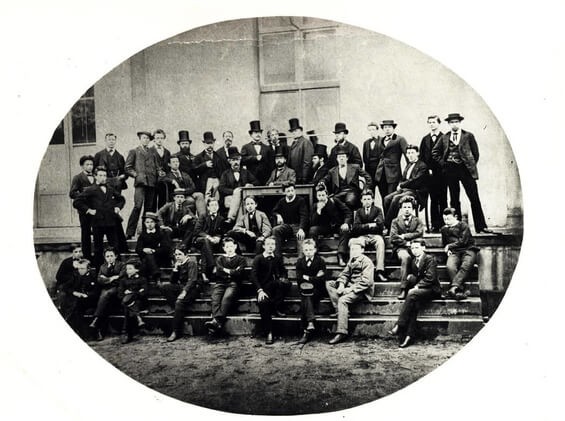
Van Gogh (likely third from right in the first row) on the steps of the Tilburg School. Vincents Tekenlokaal, Tilburg/Koning Willem II College, Tilburg.
March 19, 1868
Groot-Zundert, the Netherlands
Returns to live with his family.
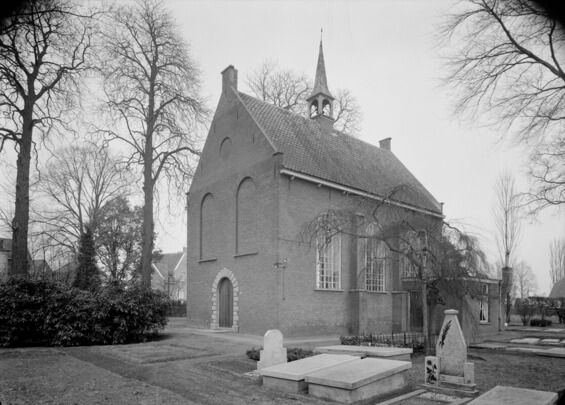
Zundert Church. Van Gogh Museum, Amsterdam, Archives.
July 30, 1869
The Hague, the Netherlands
Lodges with Willem and Dina Roos at Lange Beestenmarkt 32, after being appointed junior apprentice at the art dealership Goupil & Cie.
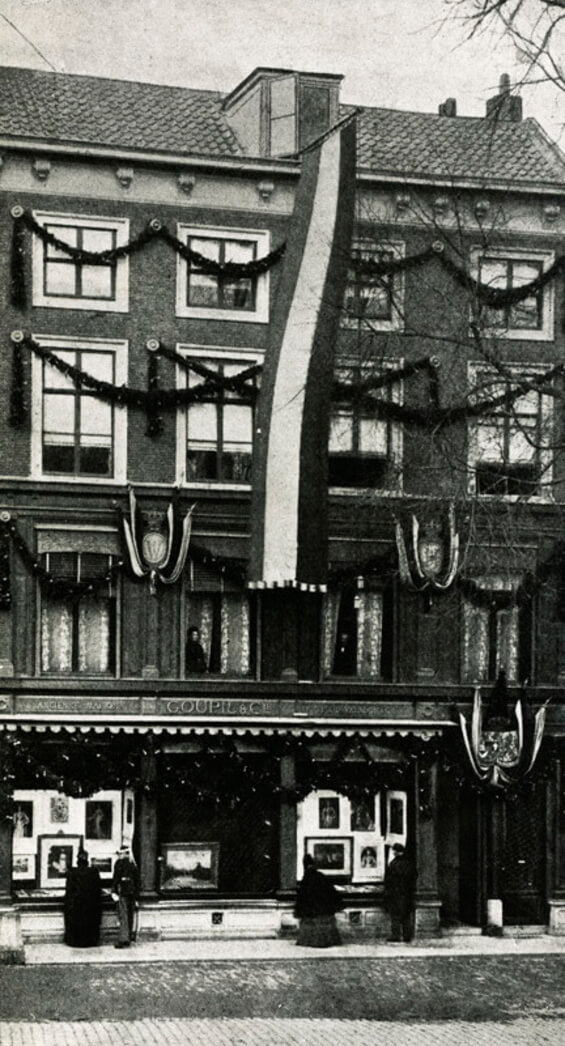
Goupil Gallery, The Hague. Collection of Mrs. Tersteeg, The Hague.
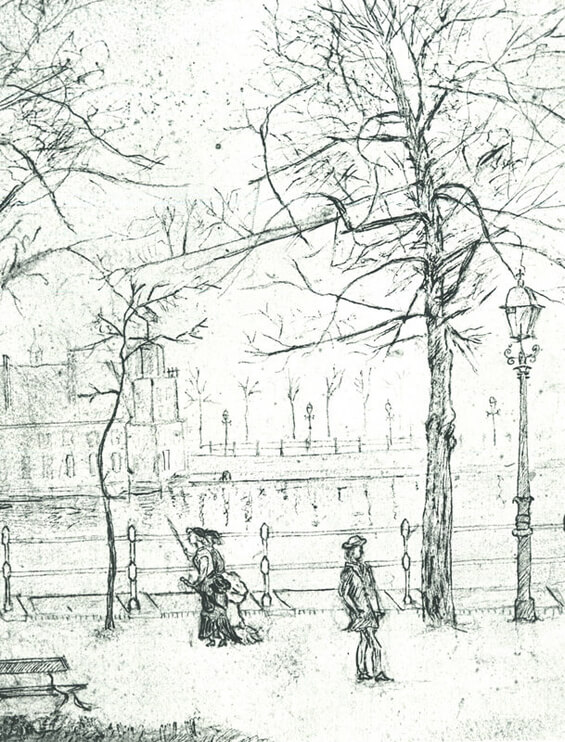
Van Gogh. Sketch of Het Binnenhof, The Hague, 1870–73. Ink and pencil; 22 × 17 cm (8 11⁄16 × 6 11⁄16 in.). Van Gogh Museum, Amsterdam (Vincent van Gogh Foundation).
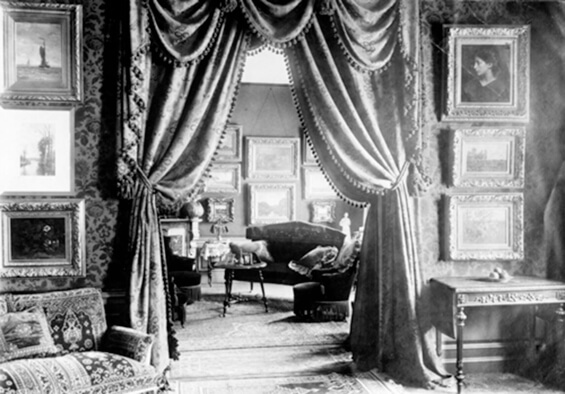
Goupil Gallery, The Hague
May 12, 1873
London, England
Moves to an unknown suburb of London to work for Goupil & Cie; en route, stays in Paris for several days.
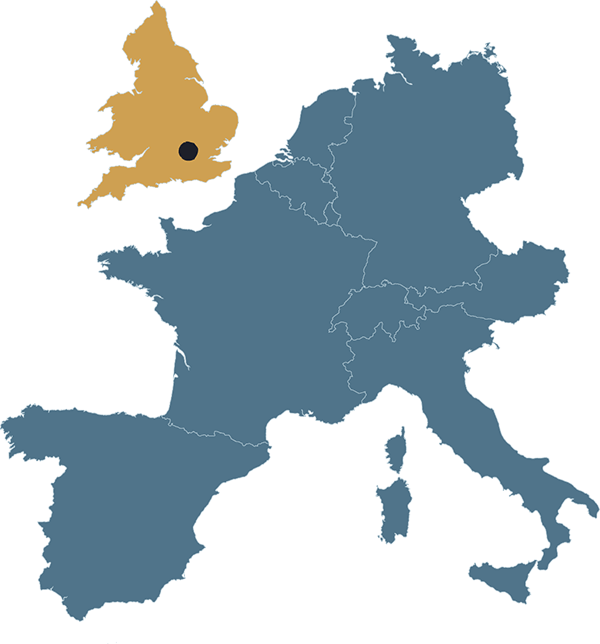
End of August 1873
Brixton, England
Moves into 87 Hackford Road, lodging with Ursula Loyer and her daughter Eugenie.
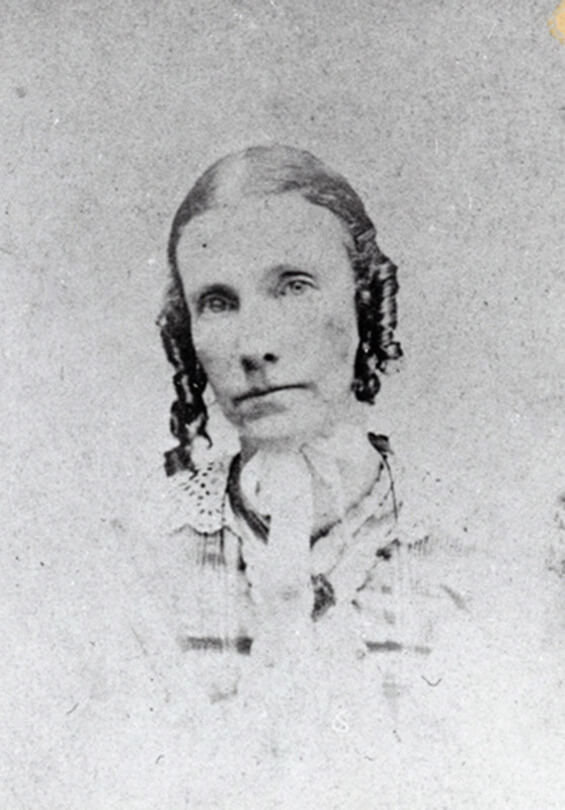
Ursula Loyer
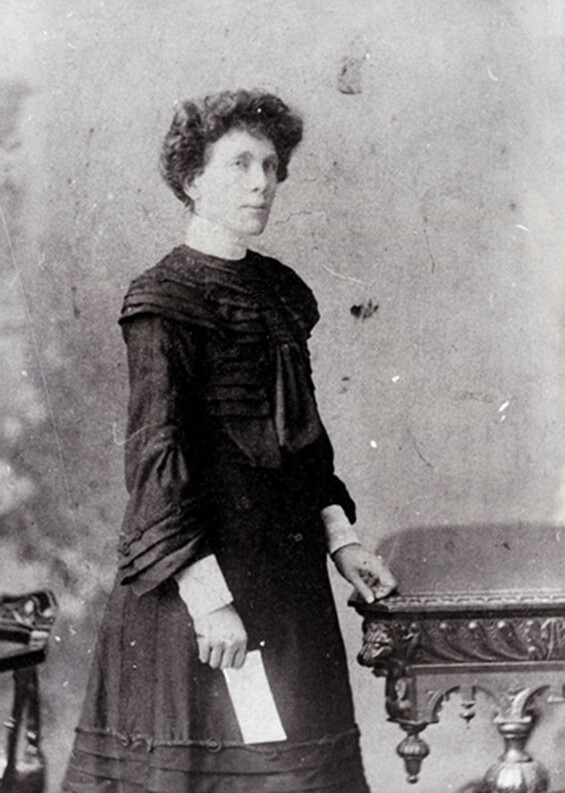
Eugenie Loyer
After August 10, 1874
London, England
Moves into the home of John Parker and his family at 395 Kennington Road, South London.
October 26, 1874
Paris, France
Temporarily transferred to the Goupil & Cie Paris branch.
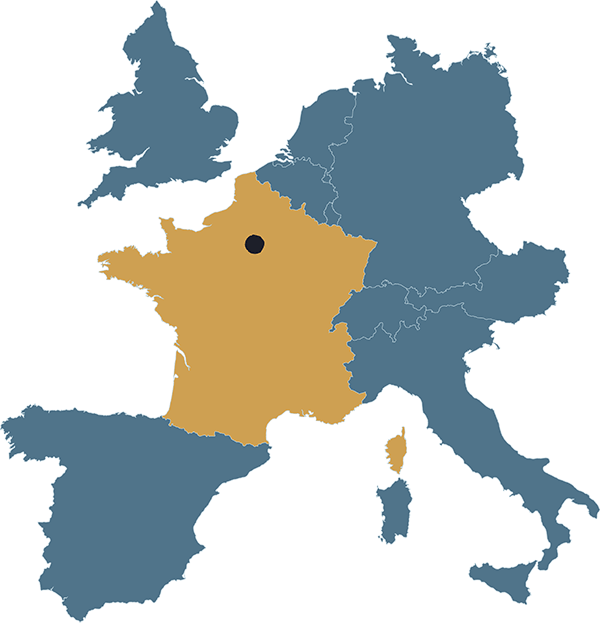
January 1875
London, England
Returns from Paris to London.
Mid-May 1875
Paris, France
Transferred back to Goupil’s branch in Paris, living in a small room in Montmartre, address unknown.
April 1, 1876
Etten, the Netherlands
After being fired from Goupil, goes to the Van Gogh family’s new home at Roosendaalseweg 4, Etten.
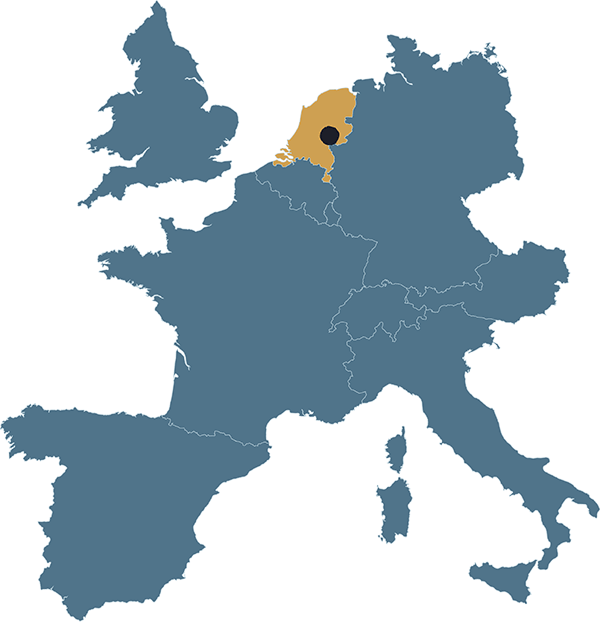
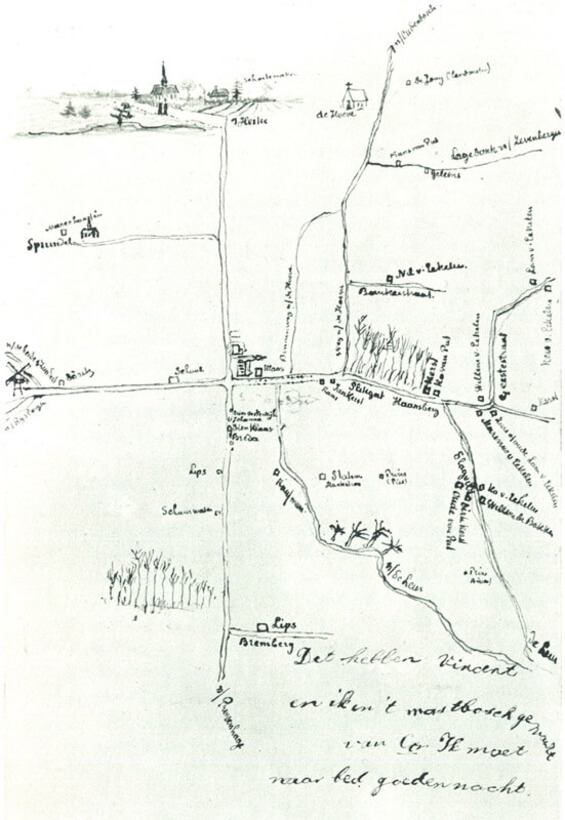
Map of Etten drawn by Van Gogh and his younger brother Cor, July 1878. Pen and ink discolored to brown on machine-made wover paper; 21 × 27.3 cm (8 ¼ × 10 ¾ in.). Van Gogh Museum, Amsterdam (Vincent van Gogh Foundation).
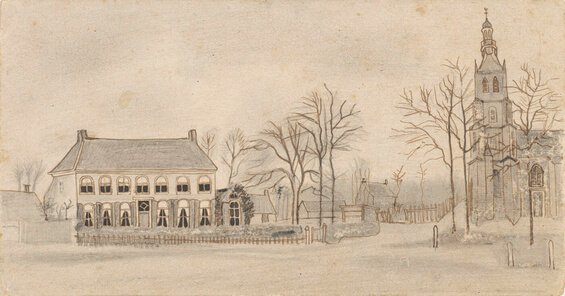
Van Gogh’s drawing of the vicarage and church at Etten, Apr. 1876. Pencil, pen and ink on paper; 9.5 × 17.8 cm (3 ¾ × 7 in.). Van Gogh Museum, Amsterdam (Vincent van Gogh Foundation).
April 14, 1876
Ramsgate, England
Lodges at 11 Spencer Square after taking a position as an assistant teacher at William Stokes’s boarding school for boys.
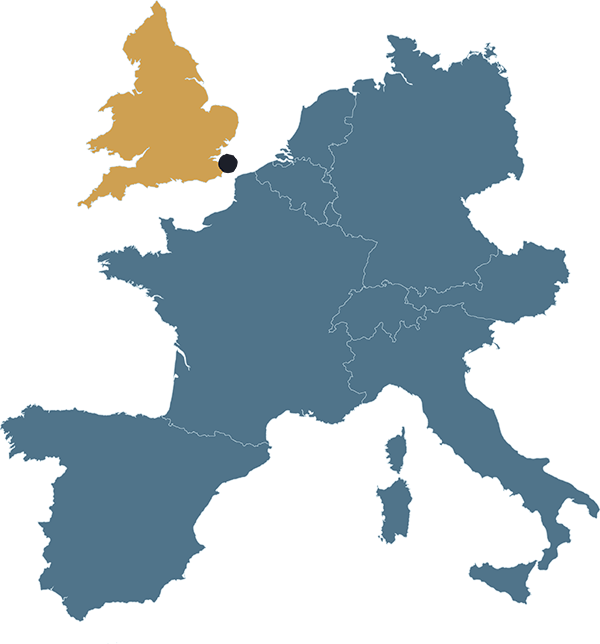
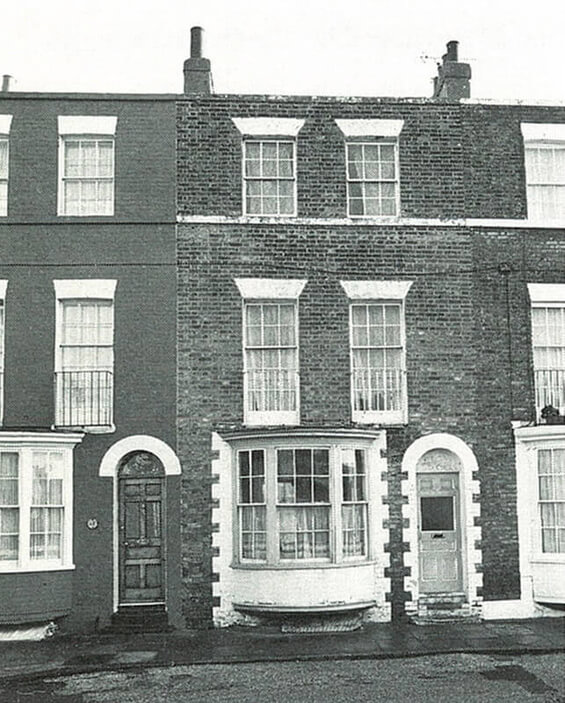
11 Spencer Square
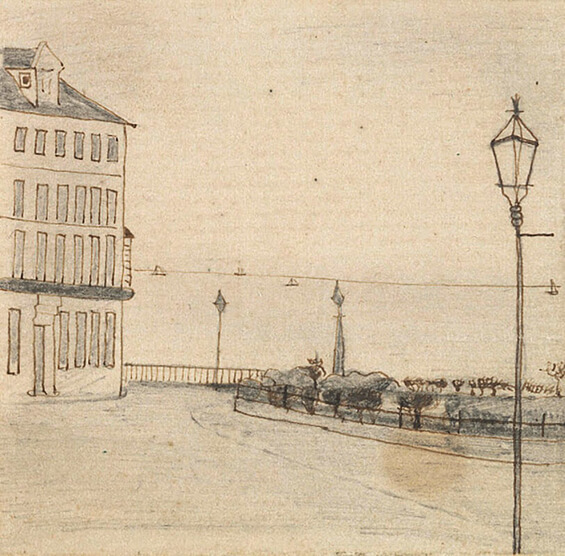
Van Gogh’s drawing of the view from the Ramsgate boarding school, May 1876. Pencil, pen, and ink on paper; 5.6 × 5.7 cm (2 3⁄16 × 2 ¼ in.). Van Gogh Museum, Amsterdam (Vincent van Gogh Foundation).
Last week of June 1876
Isleworth, England
Moves to Isleworth (near London), Linkfield House, 183 Twickenham Road, where Stokes has opened his new school.
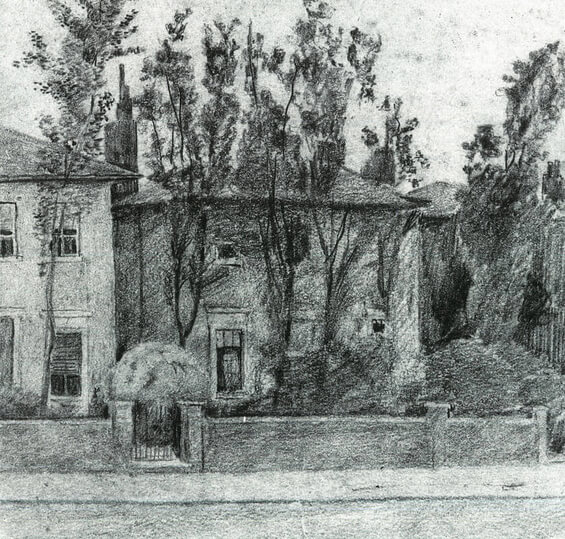
Van Gogh. Houses at Isleworth, July 1876. Pencil; 14 × 14.5 cm (5 ½ × 5 ¾ in.). Van Gogh Museum, Amsterdam (Vincent van Gogh Foundation).
By November 19, Van Gogh is preaching and teaching Sunday school at the Congregational church in Turnham Green and in Petersham.
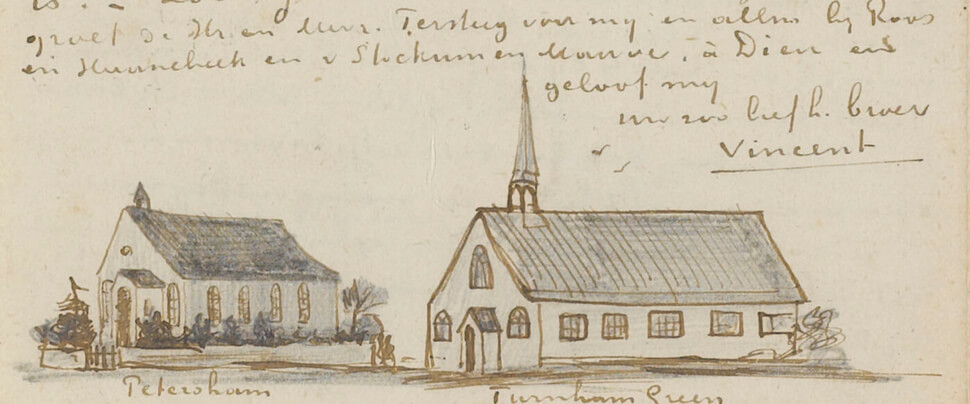
Van Gogh’s drawing of the churches at Petersham and Turnham Green, Nov. 1876. Pencil, pen, and ink on paper; 3.8 × 10 cm (1 ½ × 3 15⁄16 in.). Van Gogh Museum, Amsterdam (Vincent van Gogh Foundation).
January 9, 1877
Dordrecht, the Netherlands
Moves to Tolbrugstraat A312 and begins working as a general assistant in the Blussé & Van Braam bookshop.
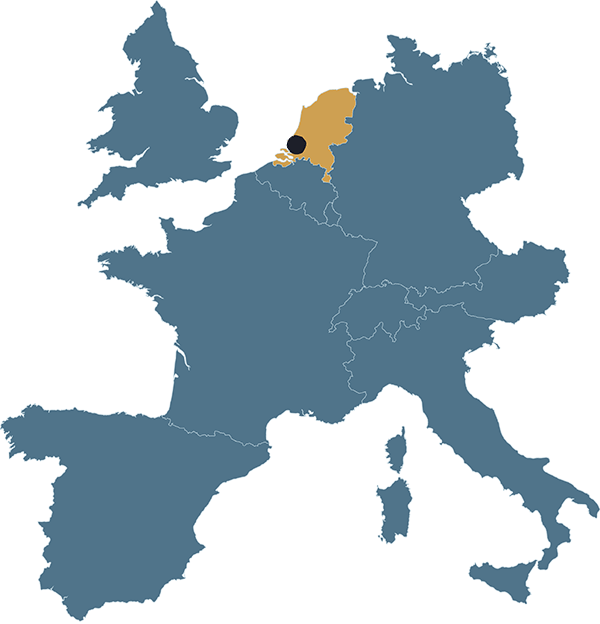
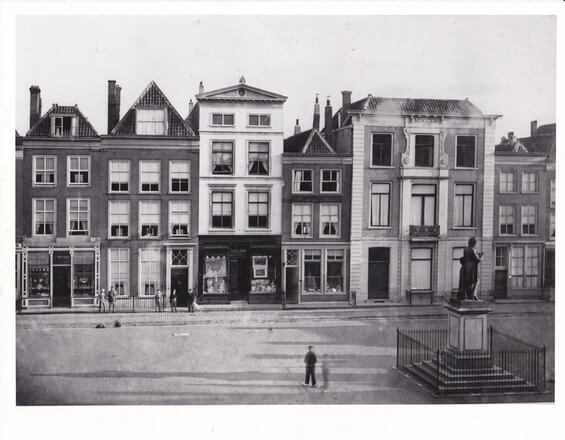
Scheffersplein, the market square in Dordrecht, with Blussé & Van Braam bookshop at center
May 14, 1877
Amsterdam, the Netherlands
Lives with his uncle, Jan van Gogh, at Grote Kattenburgerstraat 3 while preparing for his theological studies.
.jpg)
Jan van Gogh
August 26, 1878
Laken, Belgium
Moves to Laken, outside Brussels, for a three-month trial period training to be an evangelist; lodges with Plugge family at 6, chemin de Halage.
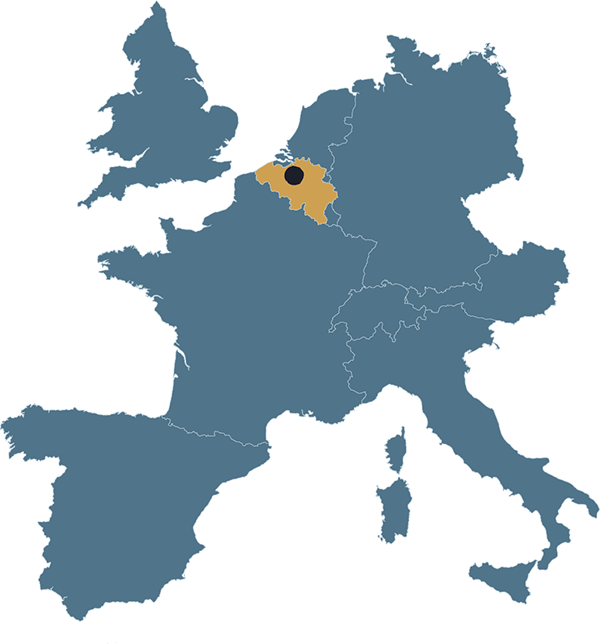
Early December 1878
Pâturages, Borinage, Belgium
Lodges until the end of December with the evangelist-colporteur Benjamin Vanderhaegen, 39, rue de l’Église.
End of December 1878
Wasmes, Borinage, Belgium
Moves in with the farmer Jean-Baptiste Denis, 81, rue du Petit-Wasmes.
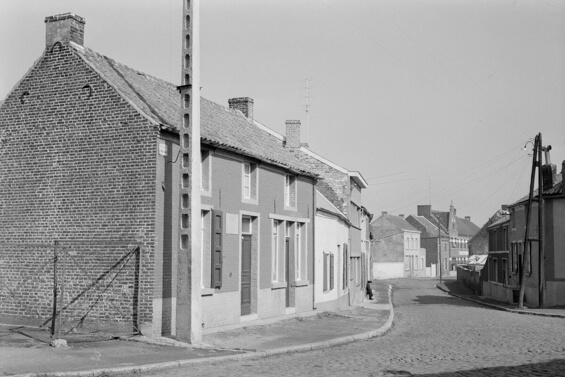
Home of Jean-Baptiste Denis. Van Gogh Museum, Amsterdam, Archives.
Early August 1879
Cuesmes, Borinage, Belgium
Lodges with the evangelist-miner Édouard Joseph Francq, 5, rue du Pavillon.
July 1880
Cuesmes, Borinage, Belgium
Moves into the home of miner Charles Decrucq, at 3, rue du Pavillon. Here, Van Gogh decides to become an artist.
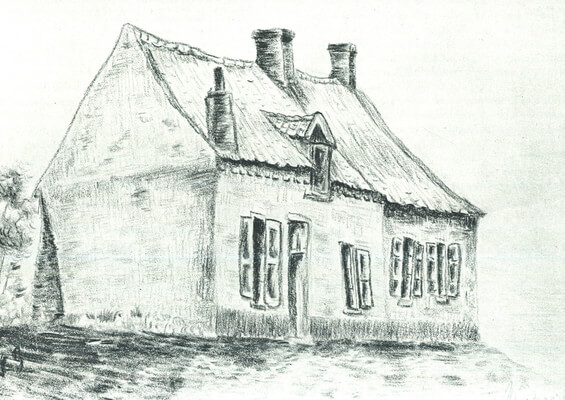
Van Gogh. The Magrot House, Cuesmes, 1879/80. Charcoal over graphite on wove paper; 23 × 29.4 cm (9 1/16 × 11 9⁄16 in.). National Gallery of Art, Washington, D.C.
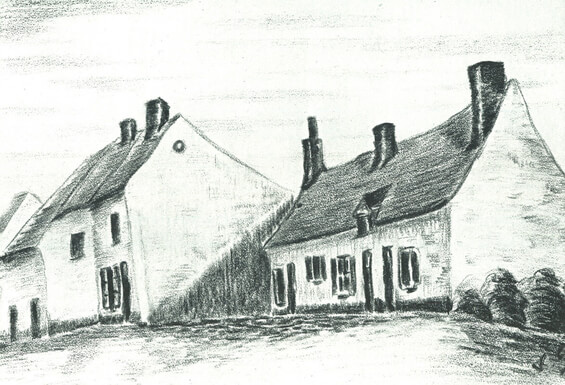
Van Gogh. The Zandmennik House, Cuesmes, 1879/80. Charcoal over graphite on wove paper; 22.8 × 29.4 cm (9 × 11 9⁄16 in.). National Gallery of Art, Washington, D.C.
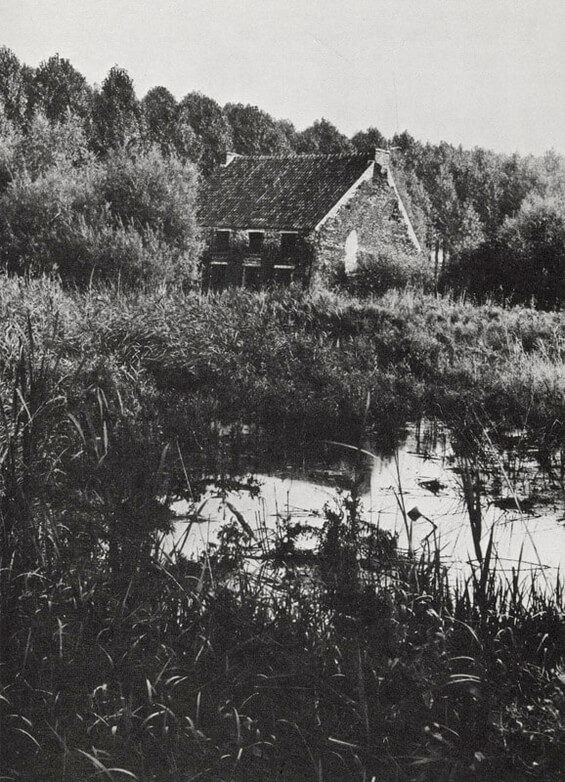
The Decrucq home before the 1976 restoration
October 1880
Brussels, Belgium
Moves to 72, boulevard du Midi.
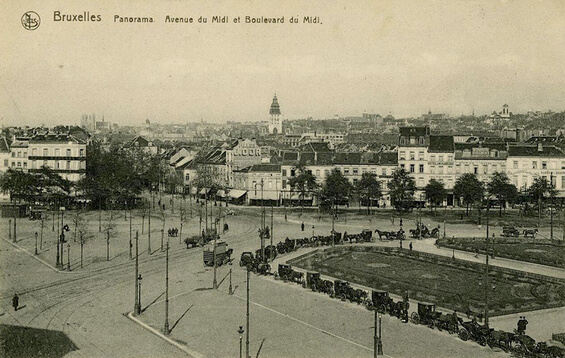
Le boulevard du Midi. Archives de la Ville de Bruxelles.
December 25, 1881
The Hague, the Netherlands
Moves after a furious argument with his father during his visit to Etten for Christmas.
January 1, 1882
The Hague, the Netherlands
Rents rooms at Schenkweg 138.
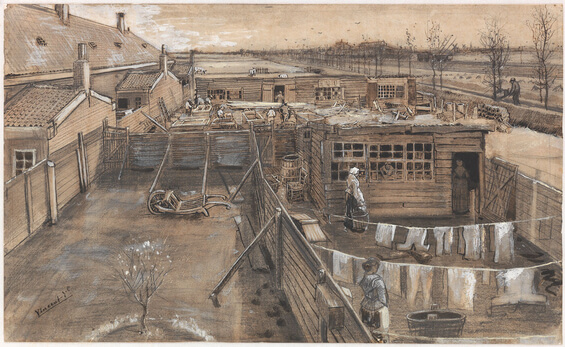
Van Gogh. Carpenter’s Yard and Laundry, late May 1882. Pencil, black chalk, pen, and brush in black ink, brown wash, opaque watercolor, scratched, traces of squaring, on laid paper; 28.6 × 46.8 cm (11 ¼ × 18 7⁄16 in.). Kröller-Müller Museum, Otterlo.
July 4, 1882
The Hague, the Netherlands
Moves to Schenkweg 136.
September 11, 1883
Hoogeveen, Drenthe, the Netherlands
Stays in Albertus Hartsuiker’s lodging house, Grote Kerksteeg 51.
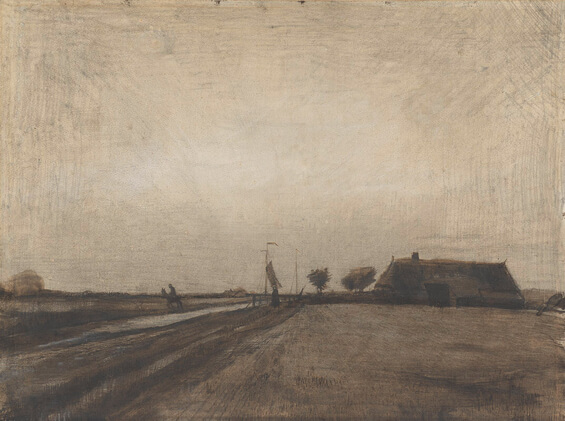
Van Gogh. Landscape in Drenthe, Sept.–Oct. 1883. Pencil, pen, brush, and ink, and watercolor on paper; 31.4 × 42.1 cm (12 ⅜ × 16 9⁄16 in.). Van Gogh Museum, Amsterdam (purchased with support from the Vincent van Gogh Foundation and the Rembrandt Association).
October 2, 1883
Nieuw-Amsterdam/ Veenoord, Drenthe, the Netherlands
Stays in lodging house run by Hendrik Scholte, District E, no. 34.
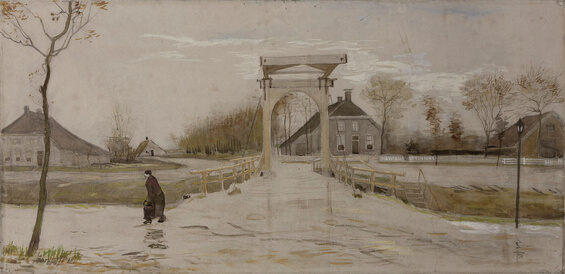
Van Gogh. Drawbridge in Nieuw-Amsterdam, 1883. Watercolor; 38.5 × 81 cm (15 3⁄16 × 31 ⅞ in.). Collection Groninger Museum, Groninger, the Netherlands.
December 5, 1883
Nuenen, the Netherlands
Lives with his parents in their new parsonage at De berg F523, Nuenen.
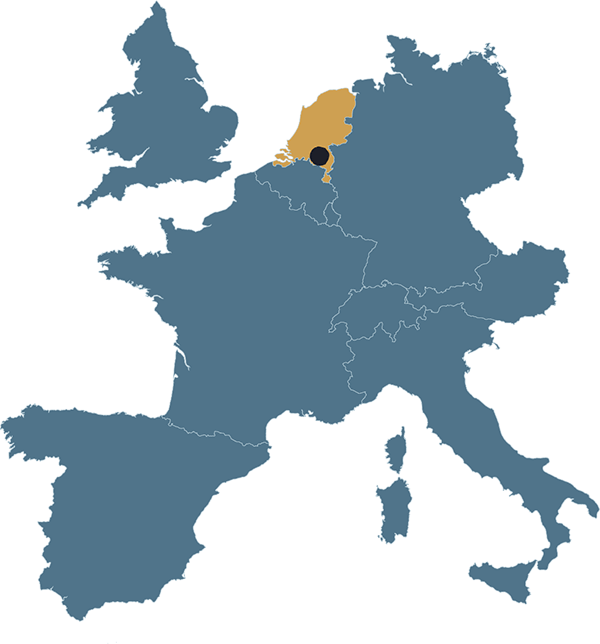
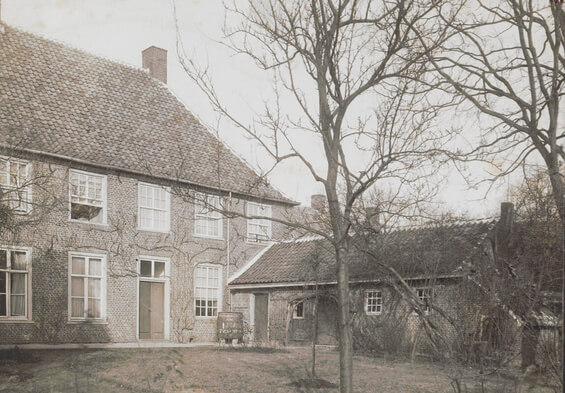
Back of parsonage with Van Gogh’s studio on the right. Van Gogh Museum, Amsterdam (Vincent van Gogh Foundation).
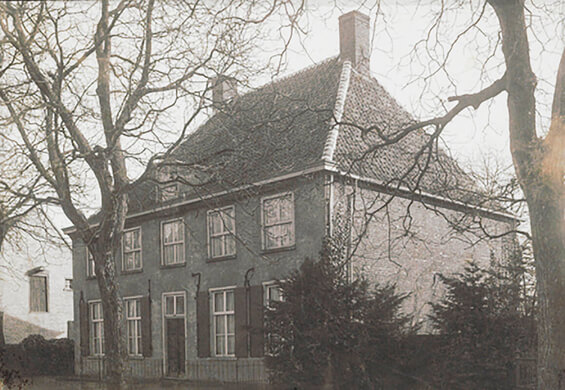
The parsonage in Nuenen
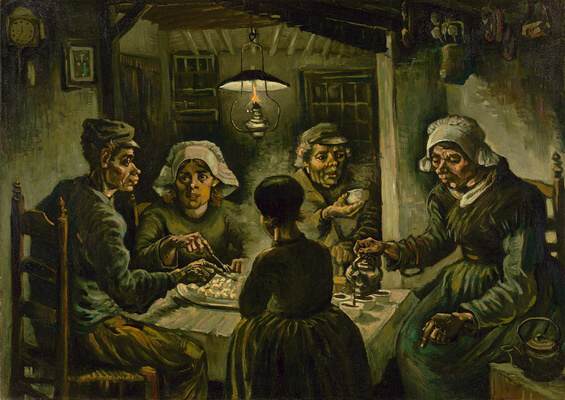
Van Gogh. The Potato Eaters, 1885. Oil on canvas; 82 × 114 cm (32 ¼ × 44 ⅞ in.). Van Gogh Museum, Amsterdam (Vincent van Gogh Foundation).
May 1885
Nuenen, the Netherlands
Moves out of parsonage and goes to live in a studio rented from Verger Schafrat.

Home of Schafrat, where he rents his studio. Van Gogh Museum, Amsterdam, Archives.
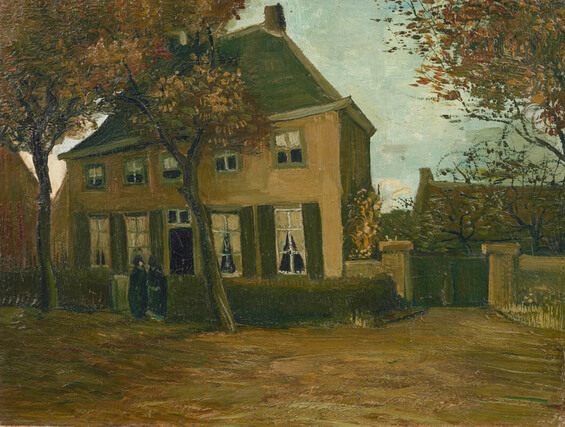
Van Gogh. The Vicarage at Nuenen, Sept.–Oct. 1885. Oil on canvas; 33.2 × 43 cm (13 × 16 15⁄16 in.). Van Gogh Museum, Amsterdam (Vincent van Gogh Foundation).
November 24, 1885
Antwerp, Belgium
Rents a room at 194, rue des Images.
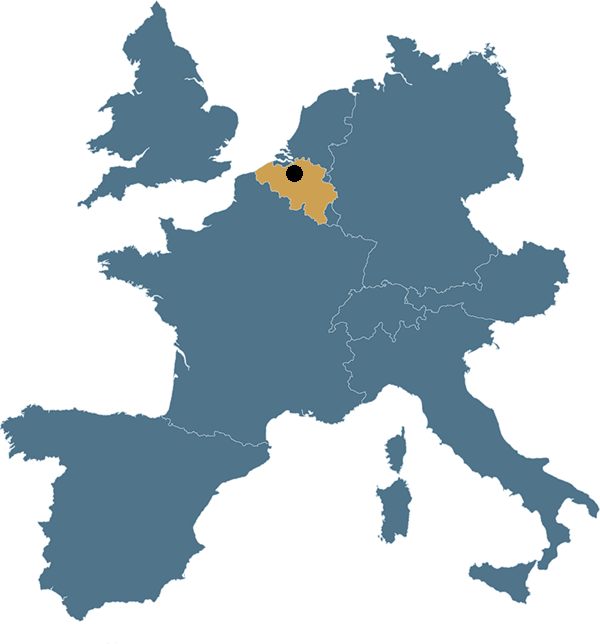
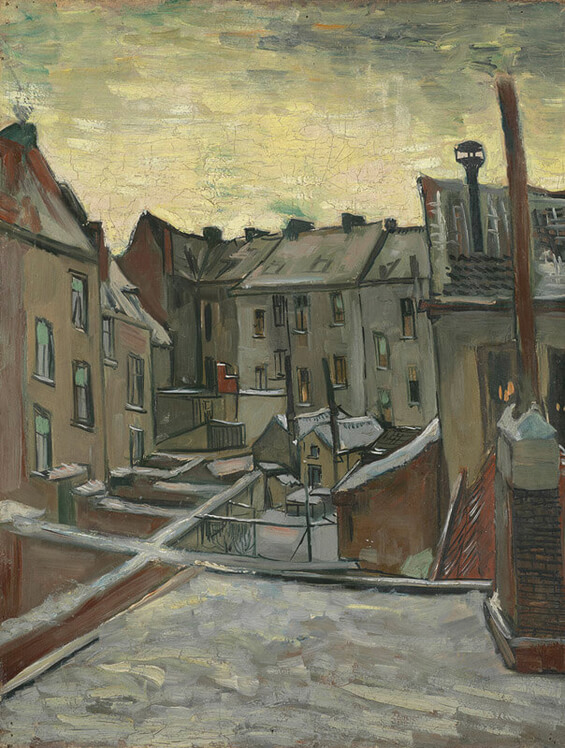
View from a window between the first and second stories at 194, rue des Images. Van Gogh. Houses Seen from the Back, Dec. 1885–Feb. 1886. Oil on canvas; 43.7 × 33.7 cm (17 3⁄16 × 13 ¼ in.). Van Gogh Museum, Amsterdam (Vincent van Gogh Foundation).
At the Antwerp Academy of Art, takes lessons in figure painting and drawing from plaster casts.
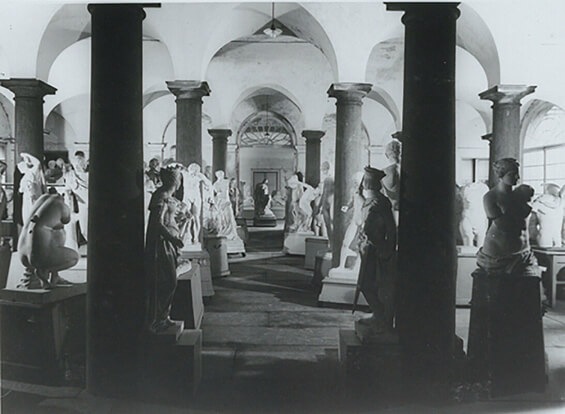
Plaster room at the Antwerp Academy of Art
Mid-March 1886
Paris, France
Lives with Theo on the rue de Laval; the small, second-floor apartment doesn’t have room for an easel, so Van Gogh works at the studio of Fernand Cormon at 104, boulevard de Clichy.
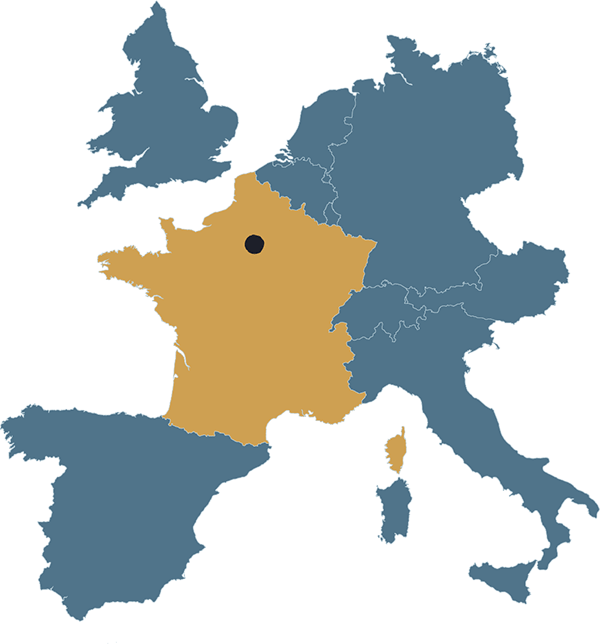
In spring of 1886, Van Gogh paints his first self-portrait.
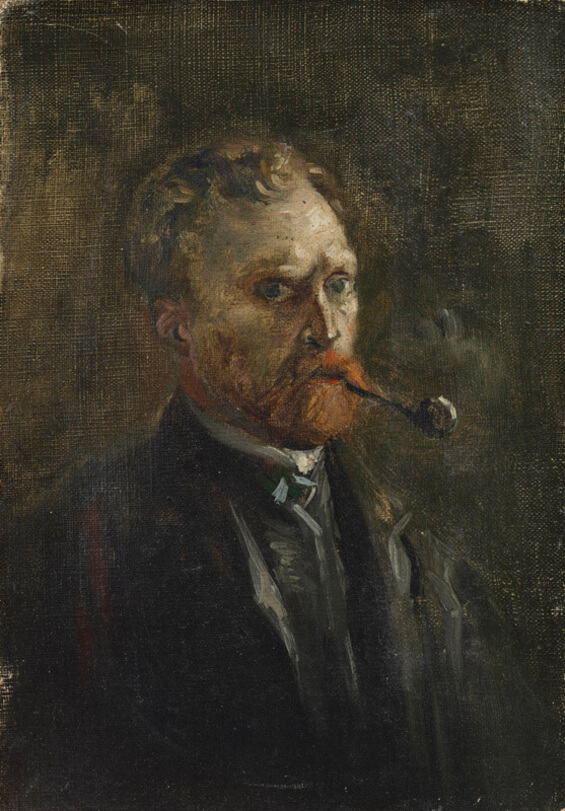
The artist’s earliest known self-portrait. Van Gogh. Self-Portrait, Mar.–June 1886. Oil on canvas; 27.2 × 19 cm (10 11⁄16 × 7 ½ in.). Van Gogh Museum, Amsterdam (Vincent van Gogh Foundation).
June 1886
Paris, France
Van Gogh and Theo move into a larger apartment at 54, rue Lepic.
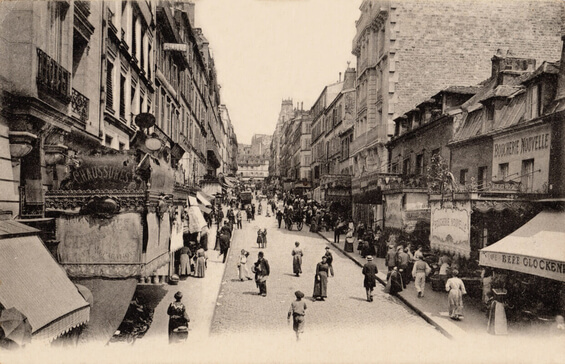
Rue Lepic, Paris. Private collection.
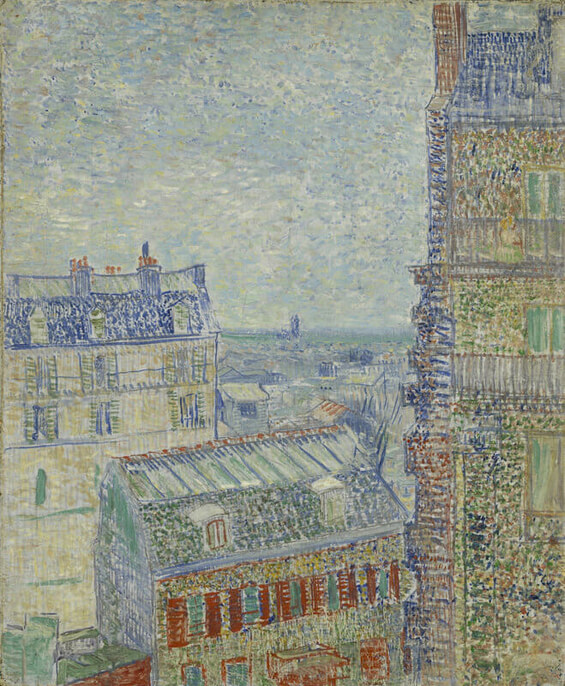
Van Gogh. View from Theo’s Apartment, Mar.–Apr. 1887. Oil on canvas; 45.9 × 38.1 cm (18 × 15 in.). Van Gogh Museum, Amsterdam (Vincent van Gogh Foundation).
November– December 1887
Paris, France
Van Gogh organizes an exhibition at the Grand Bouillon-Restaurant du Chalet, 43, avenue de Clichy; he meets Georges Seurat and Paul Gauguin when each comes to visit the exhibition.
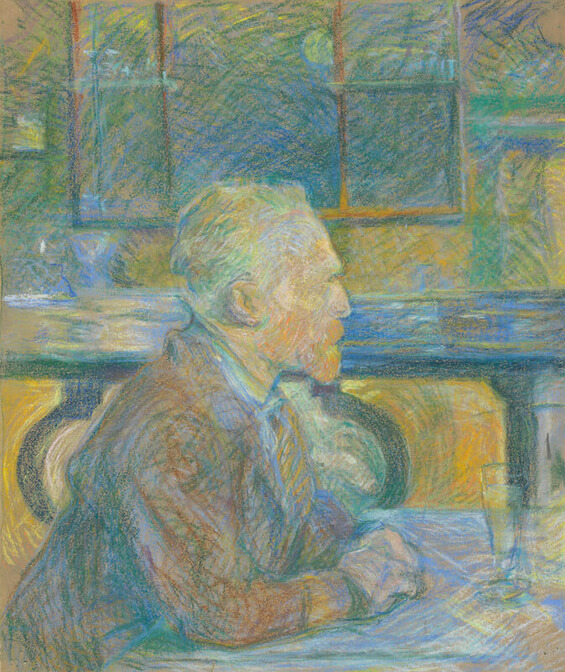
Henri de Toulouse-Lautrec (French, 1864–1901). Vincent van Gogh, 1887. Chalk on cardboard; 57 × 46 cm (22 7⁄16 × 18 ⅛ in.). Van Gogh Museum, Amsterdam (Vincent van Gogh Foundation).
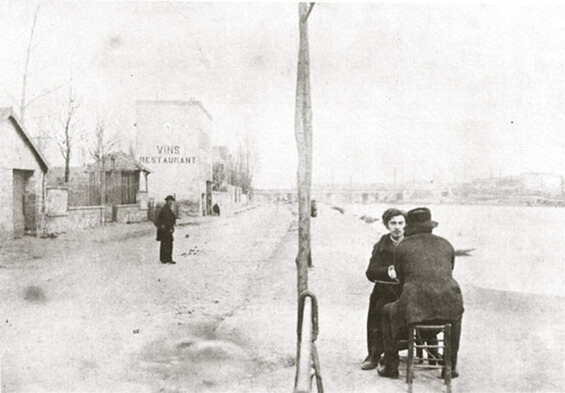
Émile Bernard and Vincent van Gogh (seen from the back) visiting Asnières, a Paris suburb, about 1887. Van Gogh Museum, Amsterdam (Vincent van Gogh Foundation).
February 19, 1888
Paris, France
Visits the studio of Georges Seurat with Theo just hours before boarding a train for Arles.
February 20, 1888
Arles, France
Van Gogh rents a room in the Hôtel-Restaurant Carrel, 30, rue Cavalerie. He uses a small covered roof terrace as his studio.
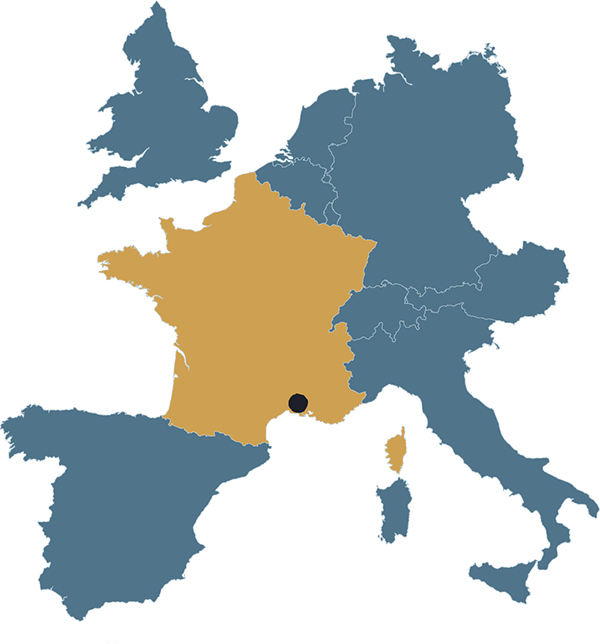
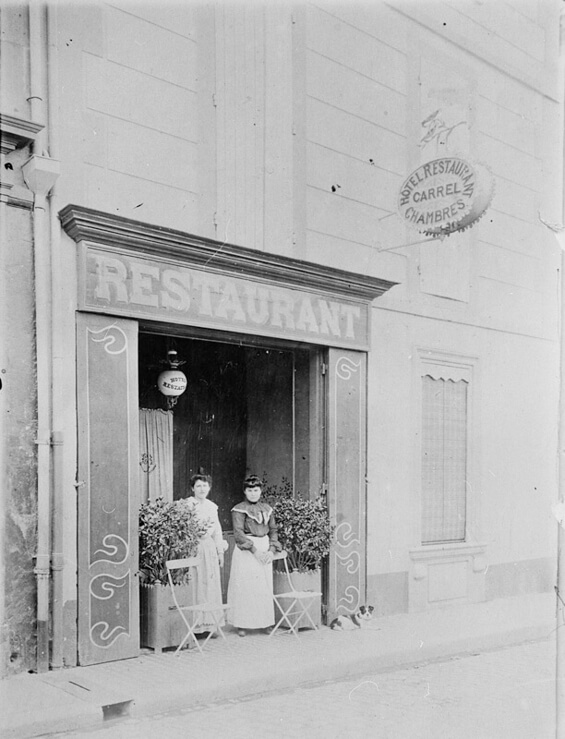
Hôtel-Restaurant Carrel. Van Gogh Museum, Amsterdam, Archives.
May 1, 1888
Arles, France
Van Gogh signs lease for the Yellow House with estate agent Bernard Soulé.
May 7, 1888
Arles, France
Temporarily takes a room in the Café de la Gare, run by Joseph-Michel and Marie Ginoux, 30, place Lamartine.
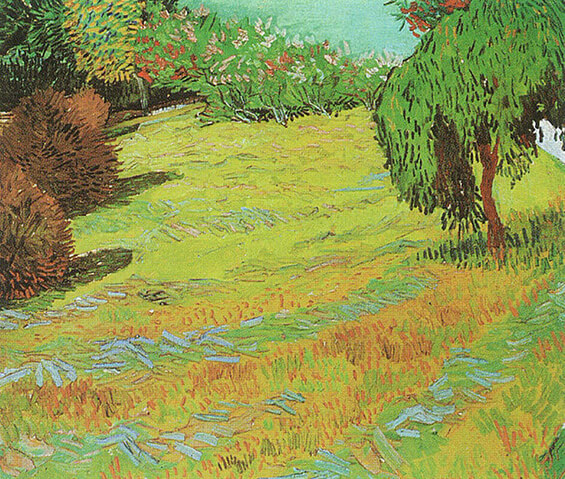
Van Gogh. Newly Mown Lawn with a Weeping Tree, 1888. Oil on canvas; 60.5 × 73.5 cm (23 13⁄16 × 28 15⁄16 in.). Kunststiftung Merzbacher, Küsnacht, Switzerland.
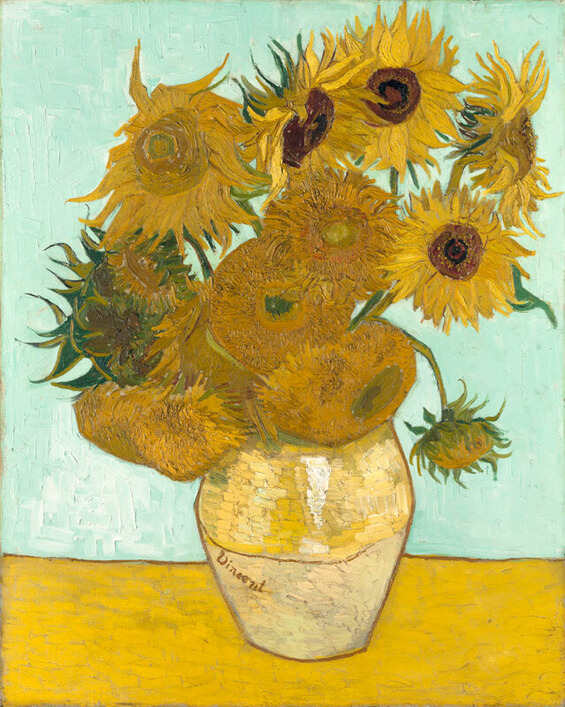
Painting hung in Paul Gauguin’s bedroom. Van Gogh. Sunflowers, Aug. 21–26, 1888. Oil on canvas; 91 × 72 cm (35 13⁄16 × 28 ⅜ in.). Neue Pinakothek, Munich.
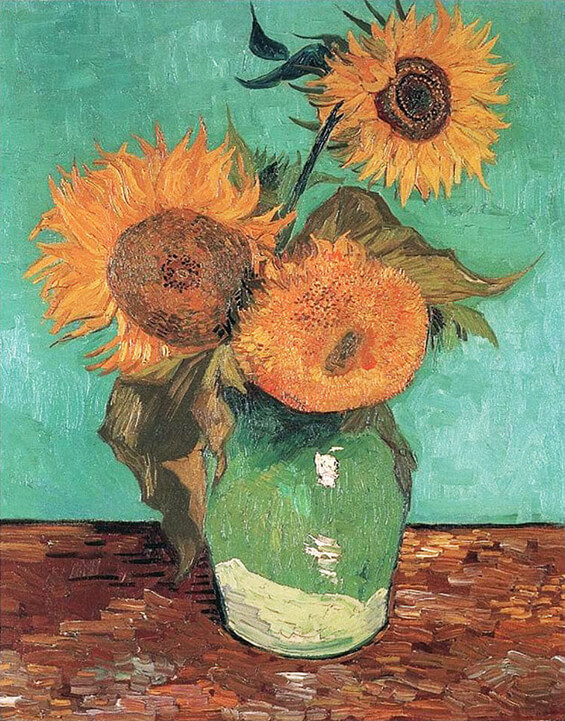
Van Gogh. Sunflowers in a Vase, Aug. 21–26, 1888. Oil on canvas; 73 × 58 cm (28 ¾ × 22 13⁄16 in.). Private collection.
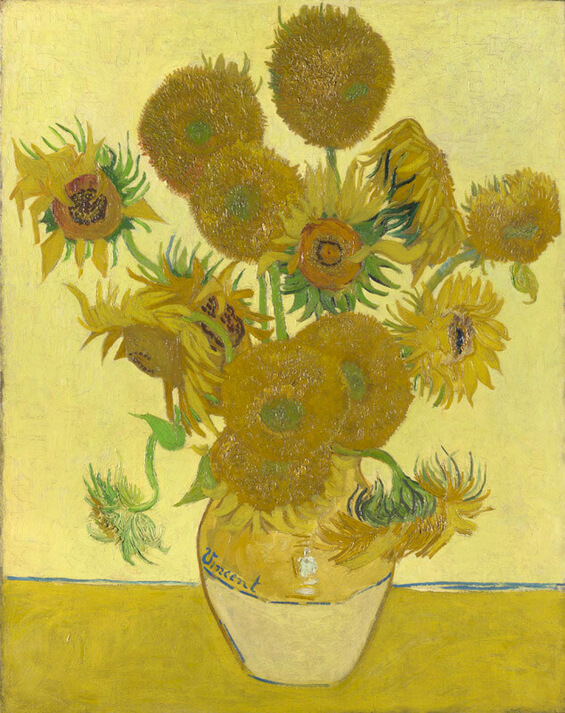
Painting hung in Paul Gauguin’s bedroom. Van Gogh. Sunflowers, about Aug. 26, 1888. Oil on canvas; 92.1 × 73 cm (36 ¼ × 28 ¾ in.). The National Gallery, London.
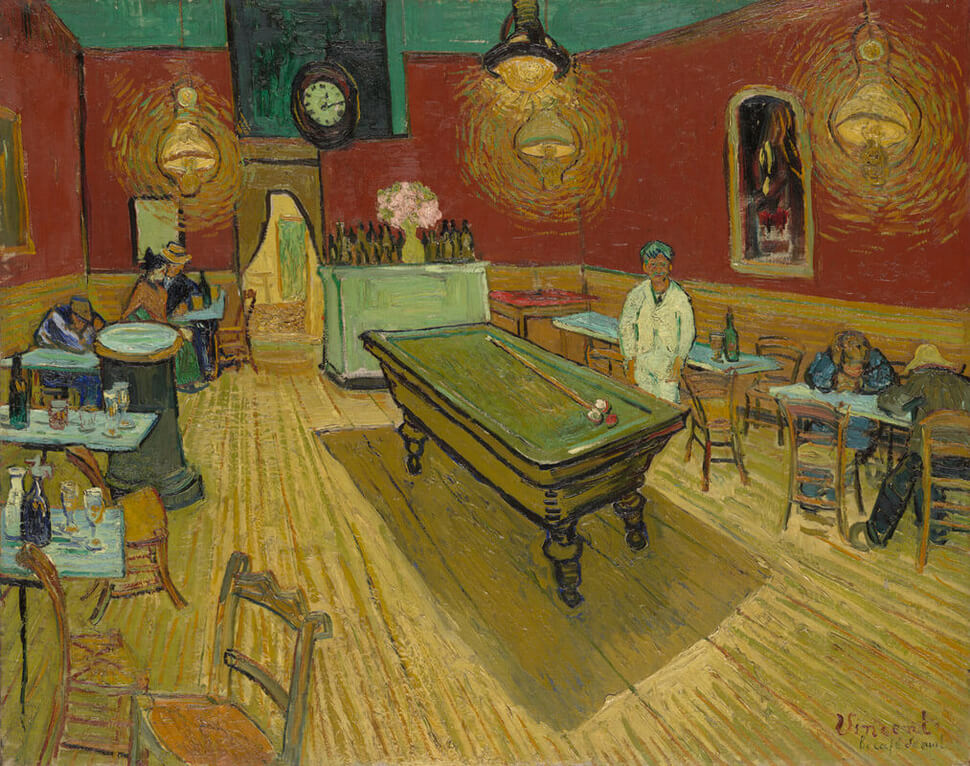
Van Gogh. The Night Café, Sept. 6–8, 1888. Oil on canvas; 70 × 89 cm (27 9⁄16 × 35 1⁄16 in.). Yale University Art Gallery, New Haven, Conn.
September 17, 1888
Arles, France
Van Gogh moves into the Yellow House on the place Lamartine.
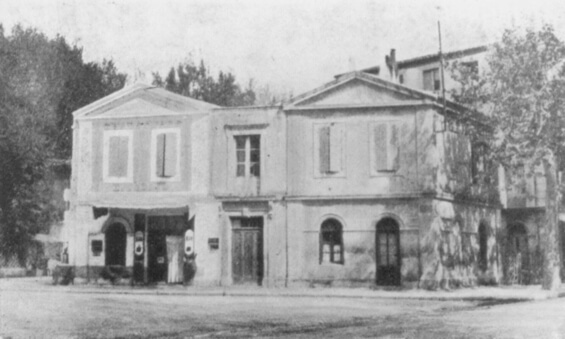
The Yellow House. Van Gogh Museum, Amsterdam, Archives.
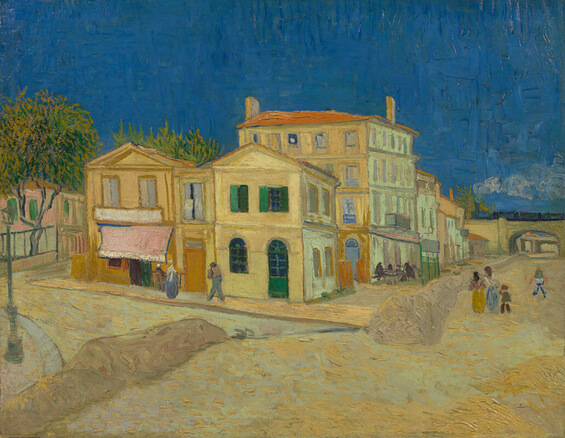
Van Gogh. The Yellow House (The Street), Sept. 28, 1888. Oil on canvas; 72 × 91.5 cm (28 ⅜ × 36 in.). Van Gogh Museum, Amsterdam (Vincent van Gogh Foundation).
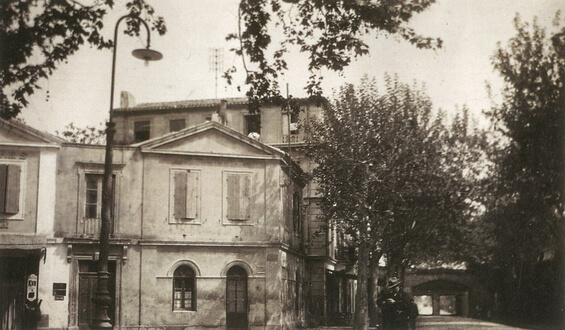
The Yellow House
October 16–17, 1888
Arles, France
After two and a half days of self-imposed bed rest, Van Gogh is inspired to paint his bedroom.
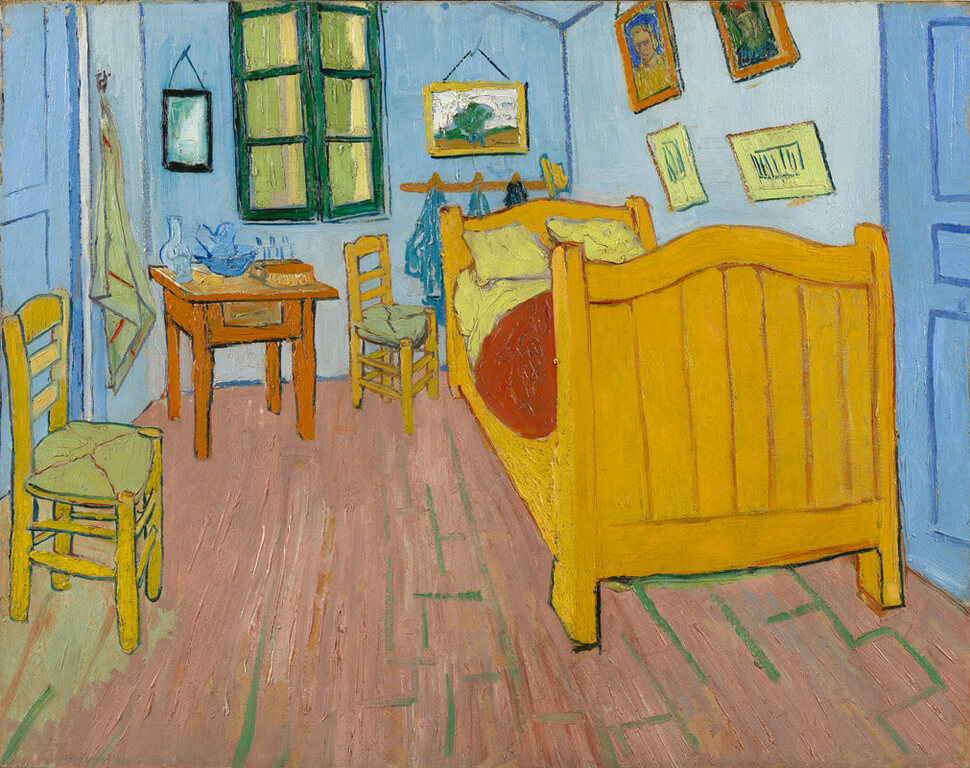
Van Gogh. The Bedroom, Oct. 16–17, 1888. Oil on canvas; 72.4 × 91.3 cm (28 ½ × 35 15⁄16 in.). Van Gogh Museum, Amsterdam (Vincent van Gogh Foundation).
October 23, 1888
Arles, France
Gauguin moves into the Yellow House.
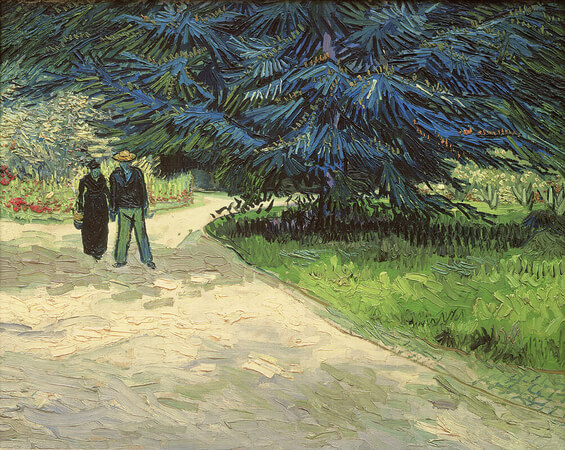
Painting hung in Paul Gauguin’s bedroom. Van Gogh. Public Garden with Couple and Blue Fir Tree: The Poet’s Garden III, Oct. 6–13, 1888. Oil on canvas; 71 × 92 cm (27 15⁄16 × 36 ¼ in.). Private collection.
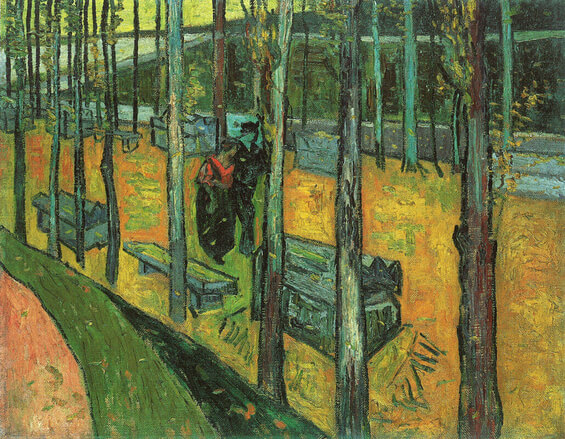
Van Gogh. The Alyscamps (“Leaf-fall”), about Nov. 1, 1888. Oil on canvas; 72 × 91 cm (28 ⅜ × 35 13⁄16 in.). Private collection.
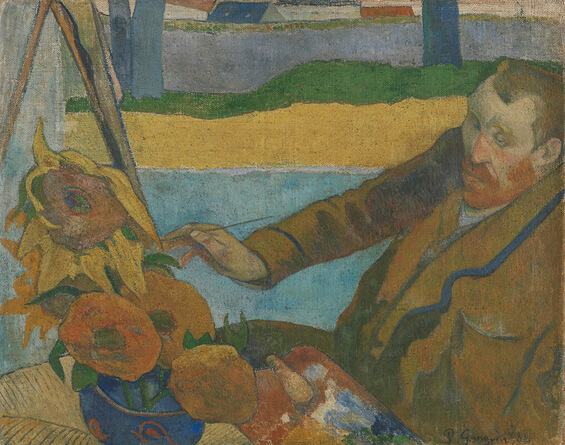
Paul Gauguin (French, 1848–1903). Vincent van Gogh Painting Sunflowers, about Dec. 1, 1888. Oil on canvas; 73 × 91 cm (28 ¾ × 35 13⁄16 in.). Van Gogh Museum, Amsterdam (Vincent van Gogh Foundation).
December 24, 1888
Arles, France
Van Gogh is admitted to the Old Hospital in Arles.
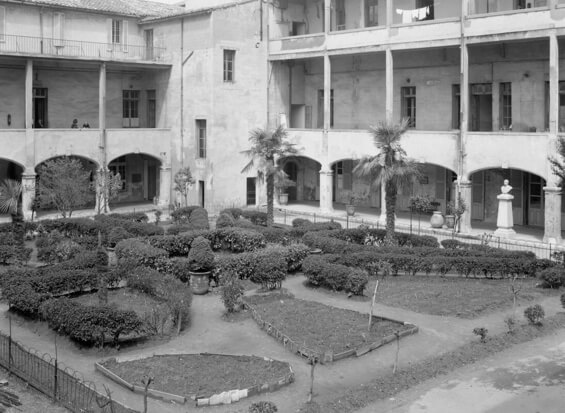
The courtyard of the hospital at Arles. Van Gogh Museum, Amsterdam, Archives.
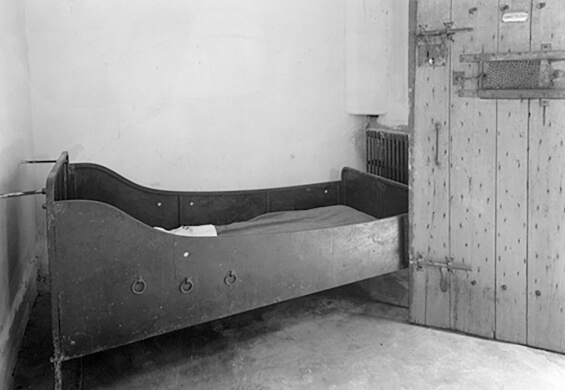
An isolation cell at the Arles hospital
December 25, 1888
Arles, France
Gauguin departs for Paris.
January 8, 1889
Arles, France
Van Gogh leaves the hospital and returns to the Yellow House.
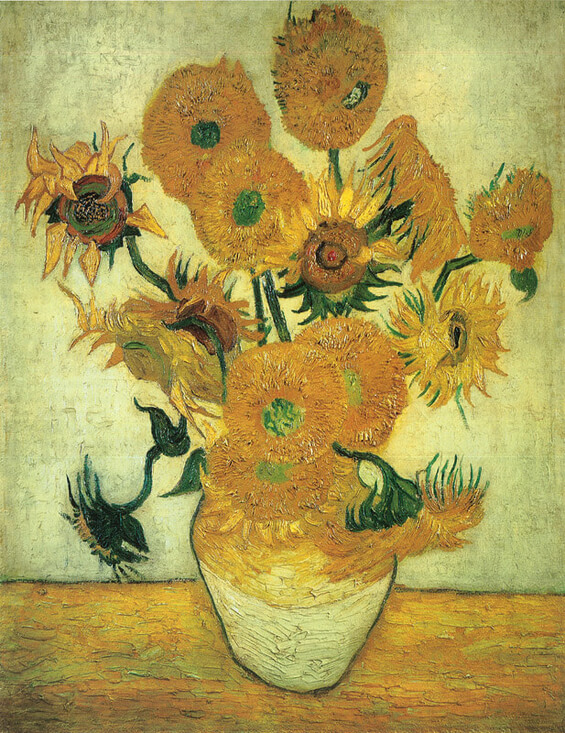
Van Gogh. Sunflowers, late January 1889. Oil on canvas; 100 × 76 cm (39 ⅜ × 29 15⁄16 in.). Seiji Togo Memorial Sompo Japan Nipponkoa Museum of Art, Tokyo.
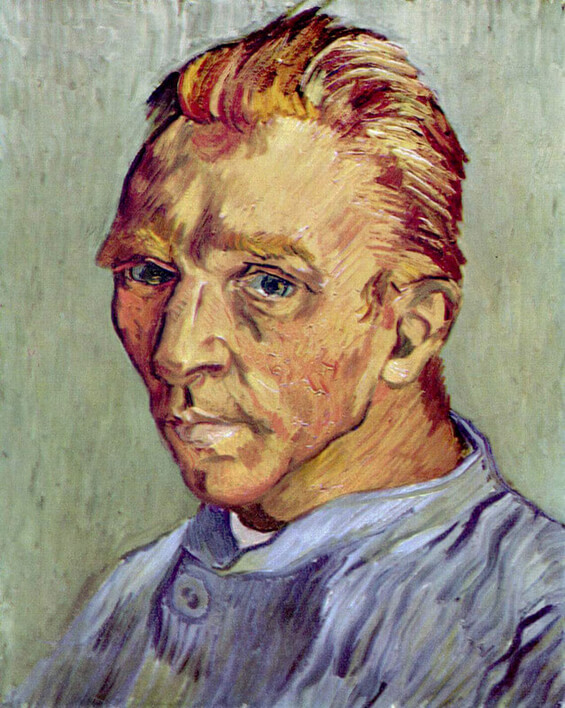
Similar to self-portrait depicted in third version of The Bedroom; painting given as a gift to his mother and sister. Van Gogh. Self-Portrait with Clean-Shaven Face, about Jan. 20, 1889. Oil on canvas; 40 × 31 cm (15 ¾ × 12 3⁄16 in.). Private collection.
._Philadelphia_Museum_of_Art.jpg)
Van Gogh. Sunflowers, late January 1889. Oil on canvas; 92.4 × 71.1 cm (36 ⅜ × 28 in.). Philadelphia Museum of Art. The Mr. and Mrs. Carroll S. Tyson, Jr., Collection. 1963.
February 7, 1889
Arles, France
Van Gogh is taken back to the Old Hospital at Arles after a second attack.
February 26, 1889
Arles, France
Van Gogh is confined to the hospital on police orders after a citizens’ petition against him.
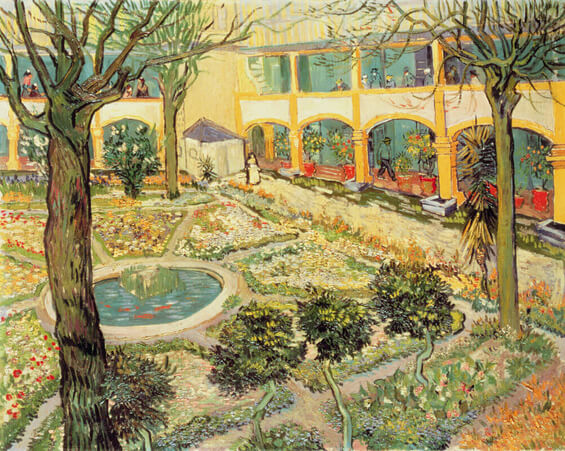
Van Gogh. Courtyard of the Hospital at Arles, Apr. 1889. Oil on canvas; 73 × 93 cm (28 ¾ × 36 ⅝ in.). Collection Oskar Reinhart « Am Römerholz », Winterthur.
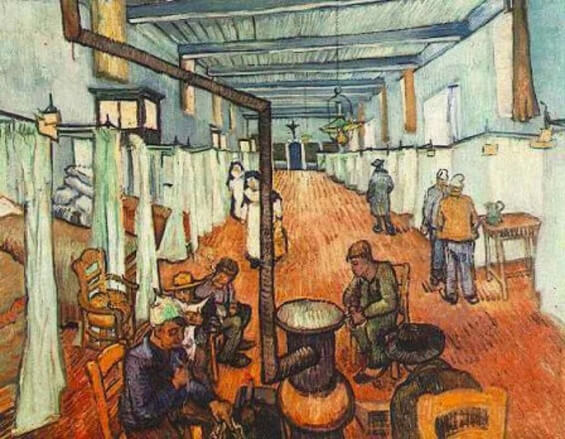
Van Gogh. The Ward in the Hospital at Arles, Apr. 1889. Oil on canvas; 72 × 91 cm (28 ⅜ × 35 13⁄16 in.). Collection Oskar Reinhart « Am Römerholz », Winterthur.
April 30, 1889
Arles, France
Flooding in the Yellow House causes water damage to several of Van Gogh’s works, including the first version of The Bedroom.
May 2, 1889
Arles, France
Van Gogh sends a crate of paintings, including the first version of The Bedroom, to Theo in Paris.
May 8, 1889
Saint-Rémy-de-Provence, France
Van Gogh admits himself to the asylum of Saint-Paul-de-Masole.
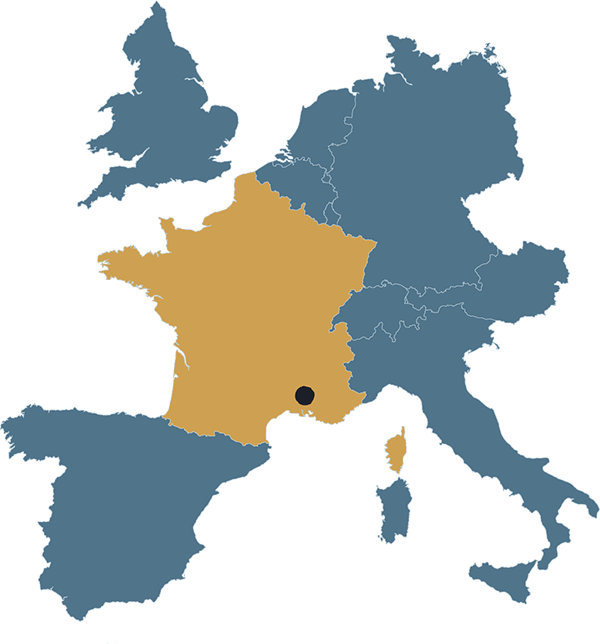
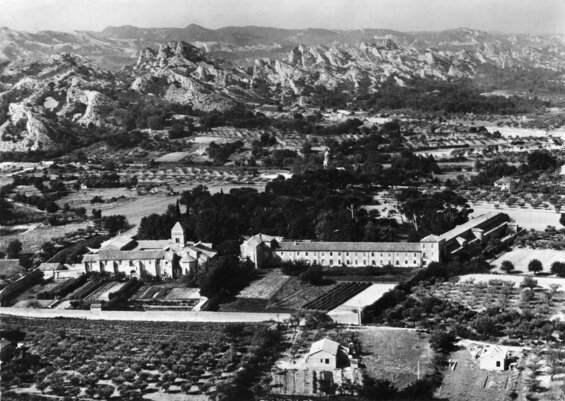
Asylum of Saint-Paul-de-Mausole, Saint-Rémy
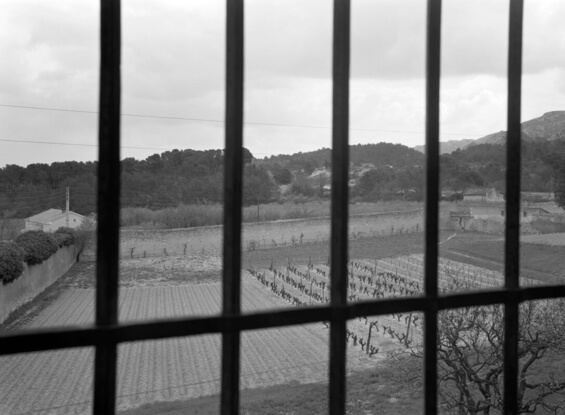
View from Van Gogh’s window in his room at Saint-Rémy. Van Gogh Museum, Amsterdam, Archives.
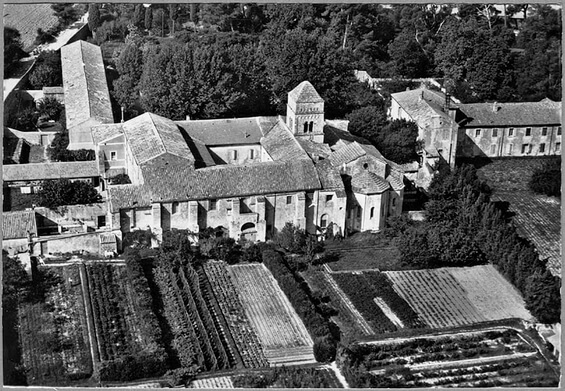
Asylum of Saint-Paul-de-Mausole, Saint-Rémy
May 23, 1889
Saint-Rémy-de-Provence, France
Van Gogh asks Theo to reline the damaged original Bedroom.
June 9, 1889
Saint-Rémy-de-Provence, France
Van Gogh asks Theo to send back the original Bedroom, instead of relining it, so that he can paint a copy.
June 16, 1889
Theo sends Van Gogh the original Bedroom from Paris to Saint-Rémy.

Cell at the Saint-Rémy asylum
July 8, 1889
Arles, France
Visits Arles.
July 14 or 15, 1889
Saint-Rémy-de-Provence, France
Returns to asylum.
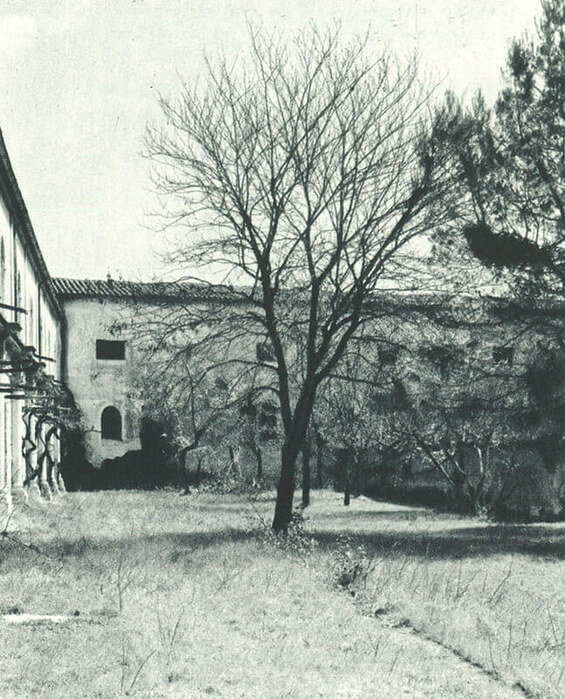
Garden of the asylum of Saint-Paul-de-Mausole, Saint-Rémy
September 5, 1889
Saint-Rémy-de-Provence, France
Van Gogh paints a second version of The Bedroom.
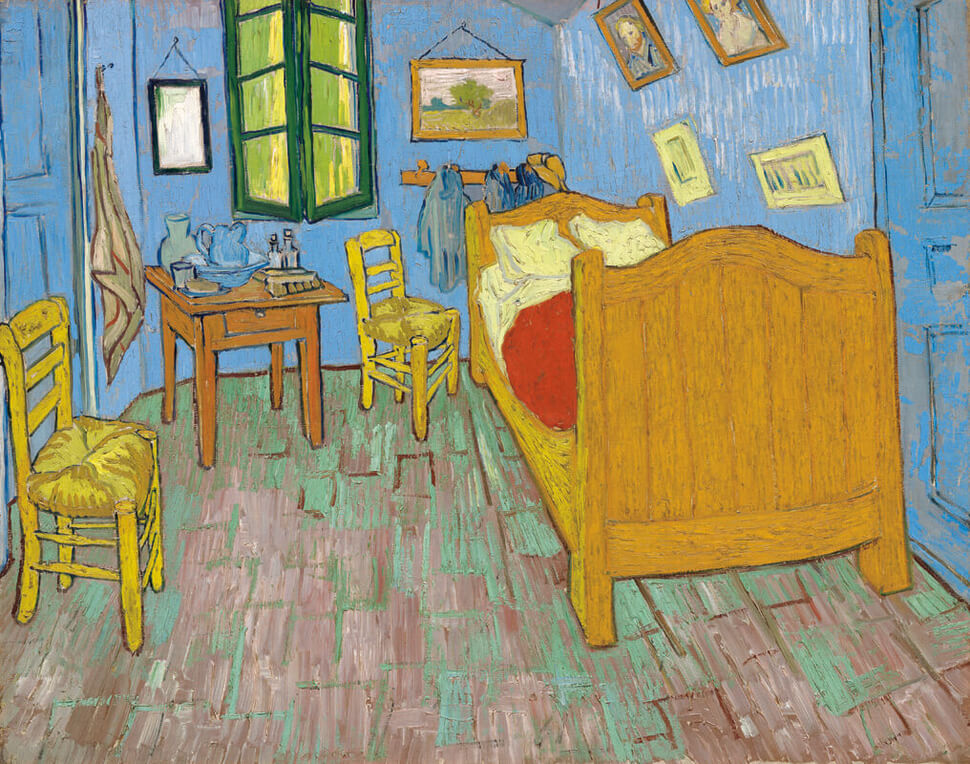
Van Gogh. The Bedroom, by Sept. 5, 1889. Oil on canvas; 73.6 × 92.3 cm (29 × 36 5⁄16 in.). The Art Institute of Chicago, Helen Birch Bartlett Memorial Collection, 1926.417.
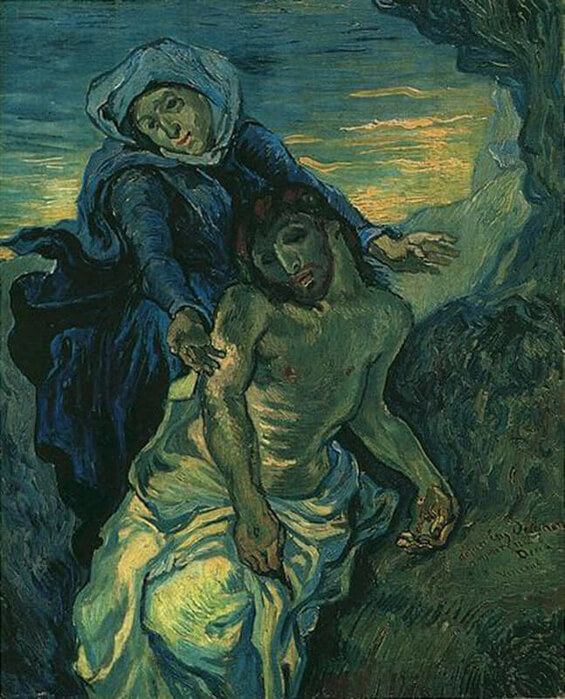
Van Gogh. Pietà after Delacroix, Sept. 6–7, 1889. Oil on canvas; 42 × 34 cm (16 9⁄16 × 13 ⅜ in.). Vatican Museum, Vatican City.
_PC.jpg)
Van Gogh. Reaper with a Scythe (after Jean-François Millet), early Sept. 1889. Oil on canvas; 43.5 × 25 cm (17 ⅛ × 9 9⁄16 in.). Private collection.
_Private_Collection.jpg)
Van Gogh. Woman with a Rake (after Jean-François Millet), Sept. 1889. Oil on canvas; 39 × 24 cm (15 ⅜ × 9 7⁄16 in.). Private collection.
September 19, 1889
Saint-Rémy-de-Provence, France
Van Gogh paints a third version of The Bedroom as a gift for his mother and sister Willemien.
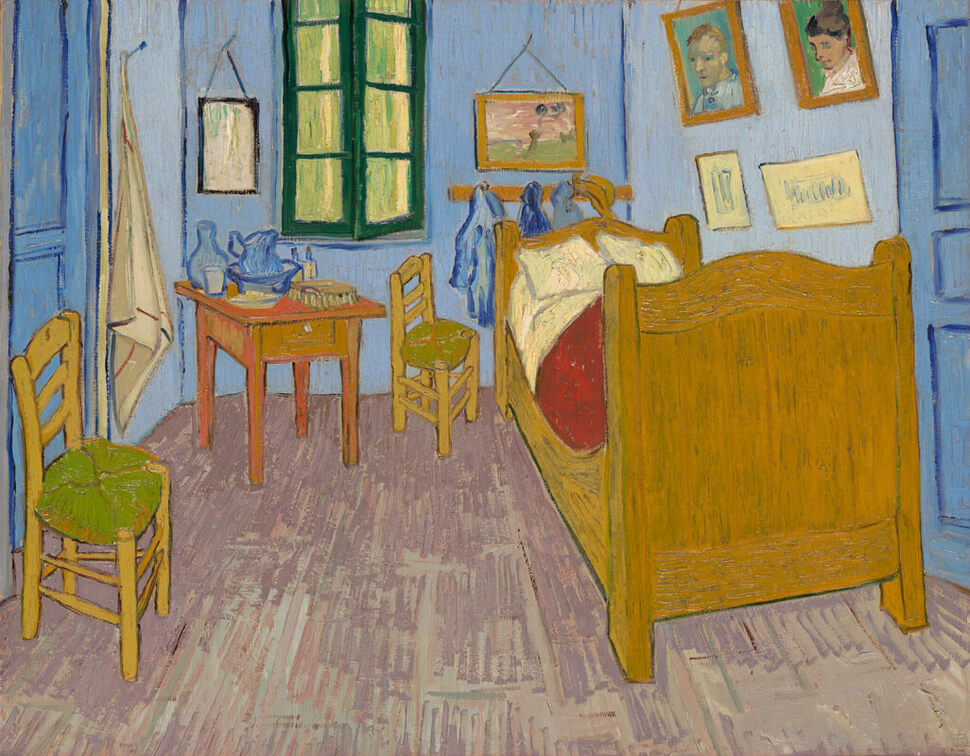
Van Gogh. The Bedroom, by Sept. 28, 1889. Oil on canvas; 57.5 × 74 cm (22 ⅝ × 29 ⅛ in.). Musée d’Orsay, Paris, sold to national museums under the Treaty of Peace with Japan, 1959.
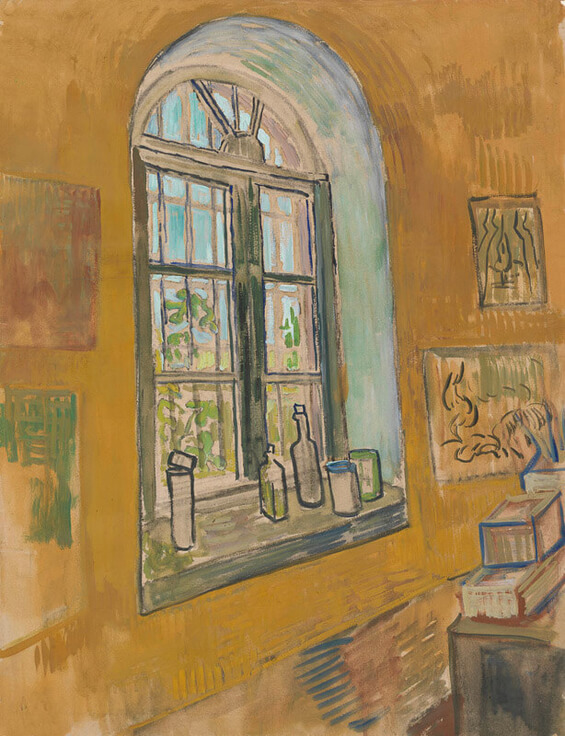
Van Gogh. Window in the Studio, Sept.–Oct. 1889. Chalk, brush and oil paint and watercolor, on paper; 62 × 47.6 cm (24 7⁄16 × 18 ¾ in.). Van Gogh Museum, Amsterdam (Vincent van Gogh Foundation).
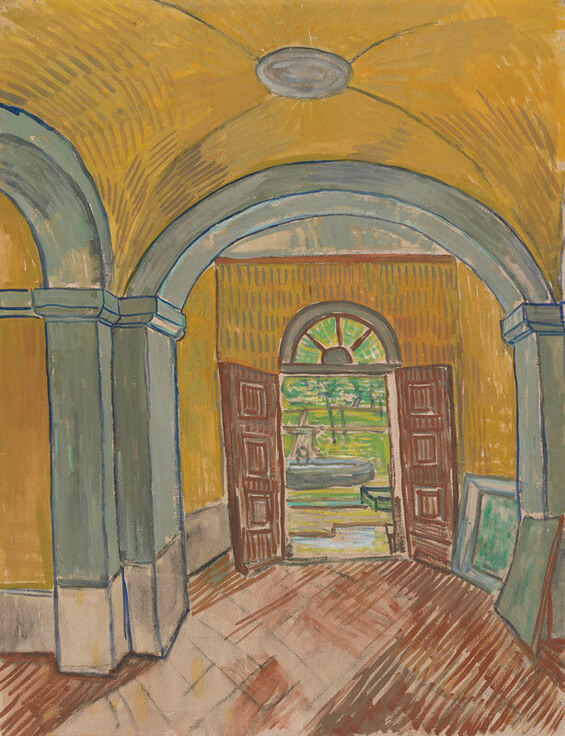
Van Gogh. Vestibule in the Asylum, Sept.–Oct. 1889. Chalk, brush, and oil paint on paper; 61.6 × 47.1 cm (24 ¼ × 18 9⁄16 in.). Van Gogh Museum, Amsterdam (Vincent van Gogh Foundation).
_Private_Collection.jpg)
Van Gogh. View of the Asylum and Chapel of Saint-Rémy, Oct. 1889. Oil on canvas; 45.1 × 60.4 cm (17 ¾ × 23 ¾ in.). Private collection.
December 6, 1889
Saint-Rémy-de-Provence, France
Van Gogh sends Theo the third version of The Bedroom to be sent on to their mother and sister Willemien.
December 18, 1889
Saint-Rémy-de-Provence, France
Van Gogh sends Theo the original and second versions of The Bedroom.
February 1890
Arles, France
Visits Arles again.
February 22, 1890
Saint-Rémy-de-Provence, France
Returns to asylum.
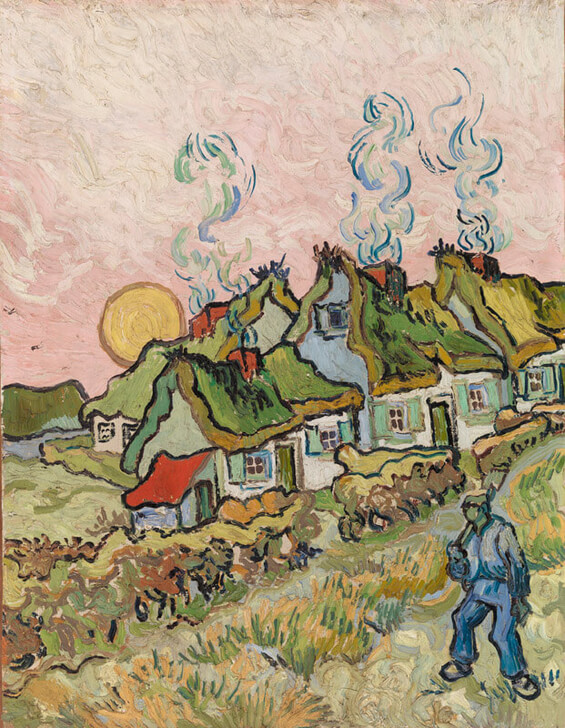
Van Gogh. House and Figure, Feb. 1890. Oil on canvas; 52 × 40.5 cm (20 ½ × 15 15⁄16 in.). The Barnes Foundation, Philadelphia.
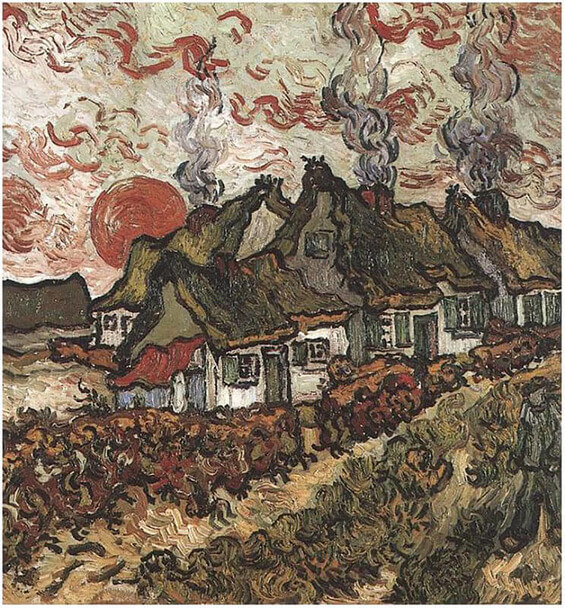
Van Gogh. Cottages at Sunset (“Reminiscence of Brabant”), Mar.–Apr. 1890. Oil on canvas; 45.5 × 43 cm (17 15⁄16 × 16 15⁄16 in.). Private collection.
May 16, 1890
Saint-Rémy-de-Provence, France
Van Gogh is discharged from the asylum.
May 17, 1890
Paris, France
Arrives in Paris and stays with Theo in his apartment at 8, cité Pigalle.
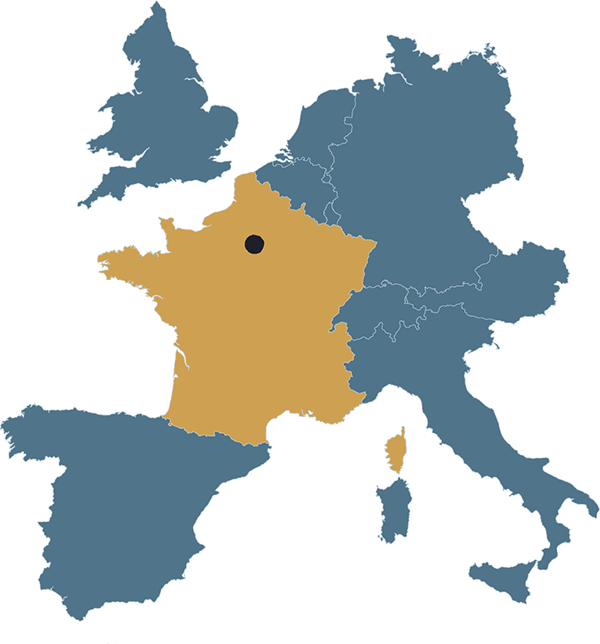
May 20, 1890
Auvers-sur-Oise, France
Van Gogh moves into the Ravoux Inn, Room 5.
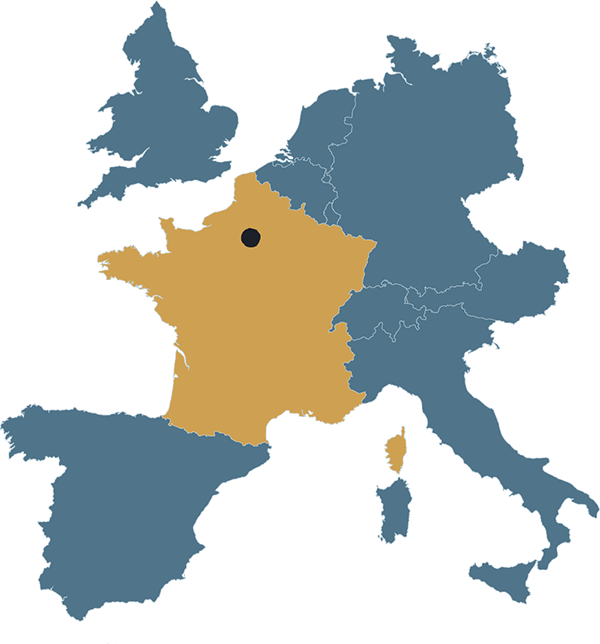
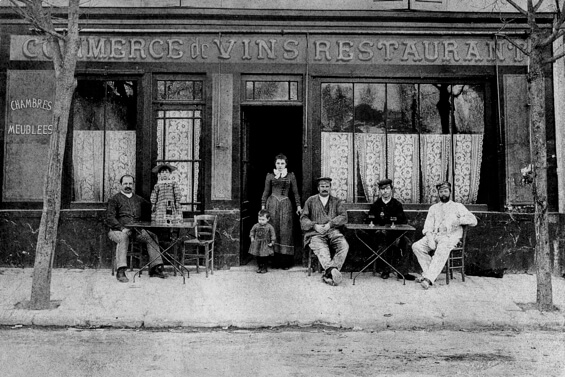
The Ravoux family in front of the Ravoux Inn
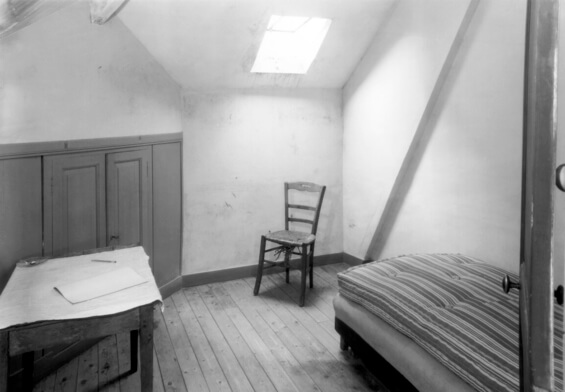
Van Gogh’s bedroom at the Ravoux Inn. Van Gogh Museum, Amsterdam, Archives.
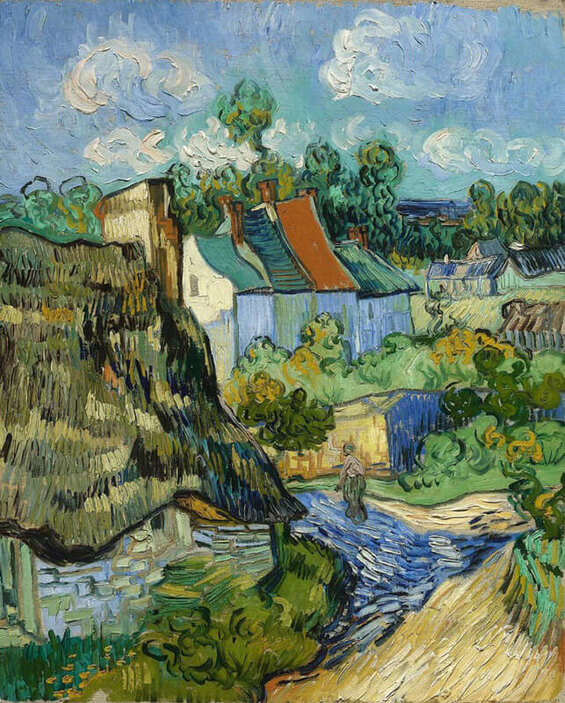
Van Gogh. Houses at Auvers, late May 1890. Oil on canvas; 75.6 × 61.9 cm (29 ¾ × 24 ⅜ in.). Museum of Fine Arts, Boston.
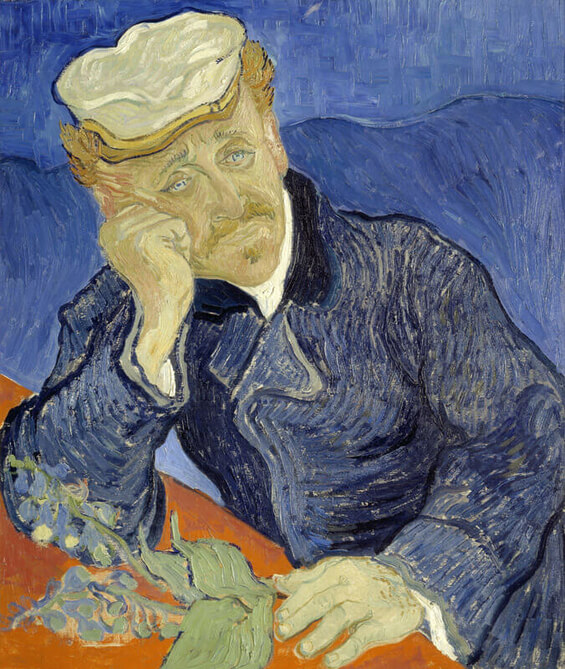
Van Gogh. Portrait of Dr. Gachet, June 3, 1890. Oil on canvas; 68 × 57 cm (26 ¾ × 22 7⁄16 in.). Musée d’Orsay, Paris, gift of Paul and Marguerite Gachet, children of the model, 1949.
_Hiroshima_Museum_of_Art.jpg)
Van Gogh. Daubigny’s Garden, about July 10, 1890. Oil on canvas; 53.2 × 103.5 cm (20 15⁄16 × 40 ¾ in.). Hiroshima Museum of Art.
_Kunsthaus_Zurich.jpg)
Van Gogh. Thatched Sandstone Cottages at Chaponval, about July 23, 1890. Oil on canvas; 65 × 81.5 cm (25 9⁄16 × 32 in.). Kunsthaus Zürich.
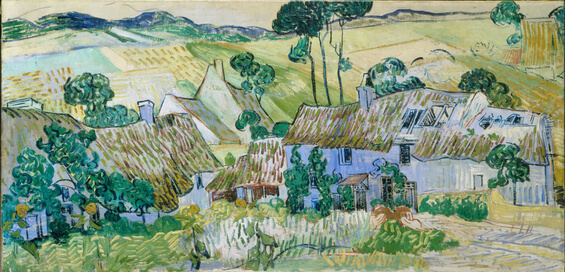
Van Gogh. Farms near Auvers, July 1890. Oil on canvas; 50.2 × 100.3 cm (19 ¾ × 39 ½ in.). Tate Gallery, London.
July 29, 1890
Auvers-sur-Oise, France
Van Gogh dies.
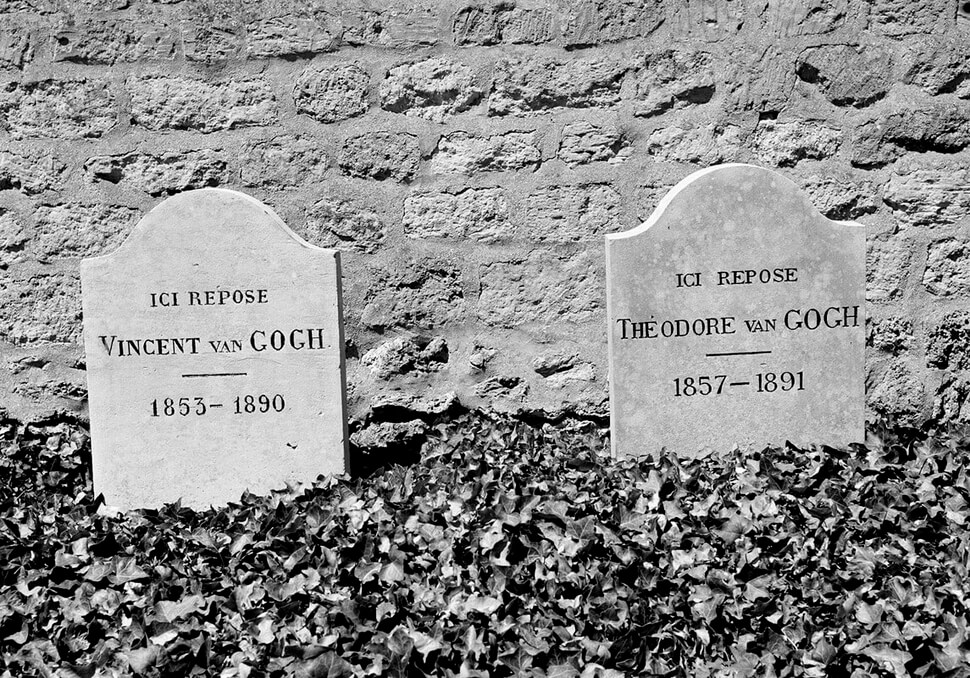
The graves of Vincent and Theo van Gogh, Auvers-sur-Oise. Ryerson and Burnham Libary Archives, Art Institute of Chicago.



© Art Institute of Chicago